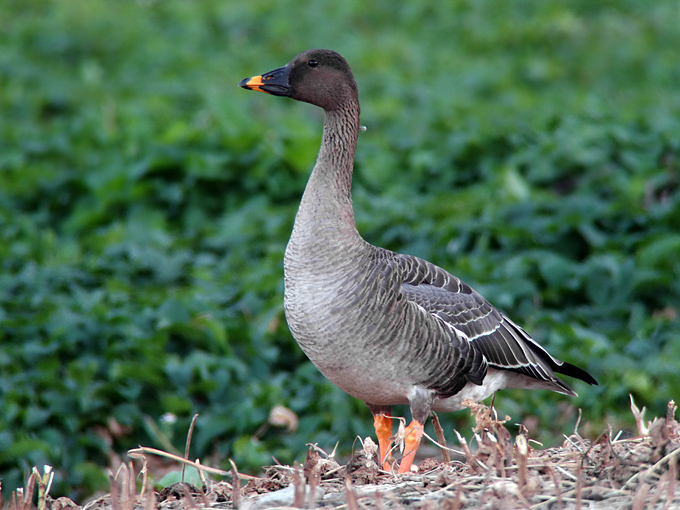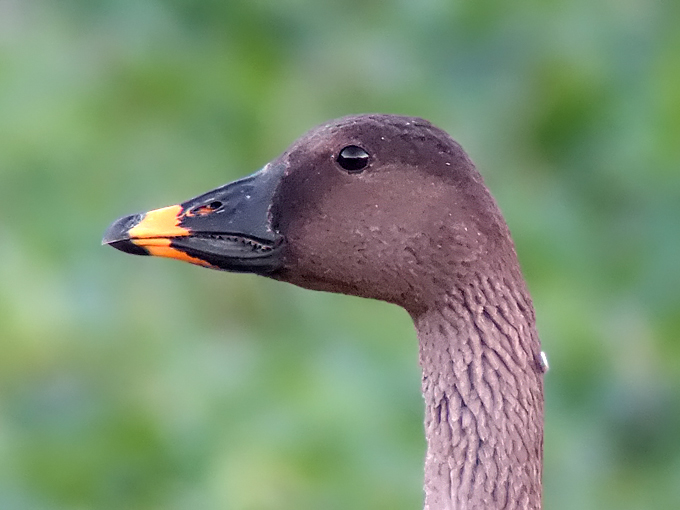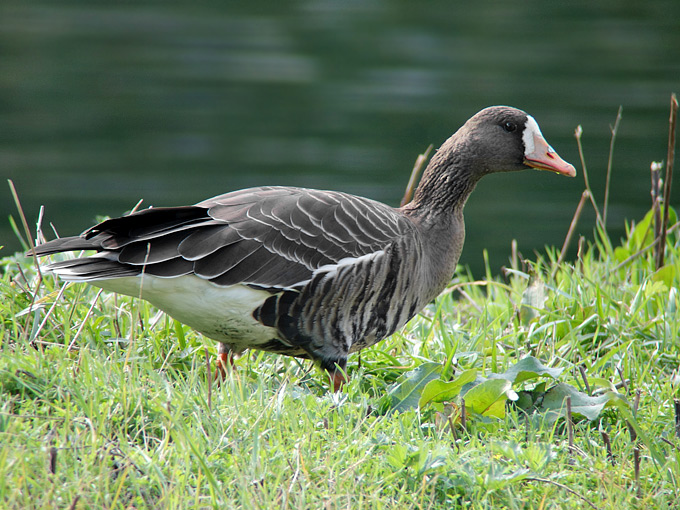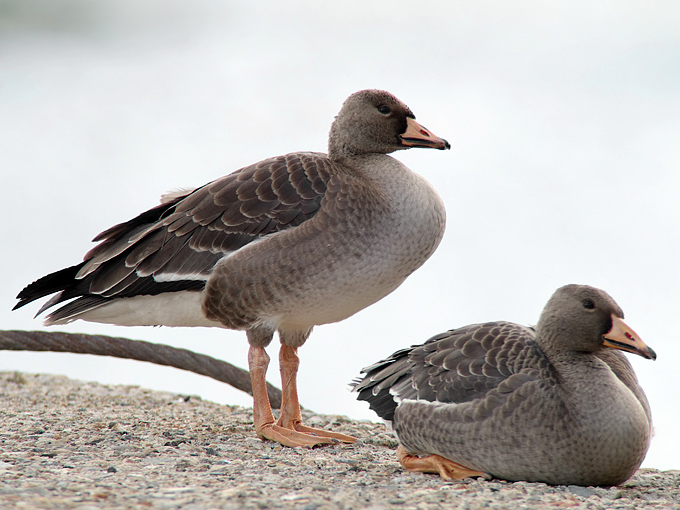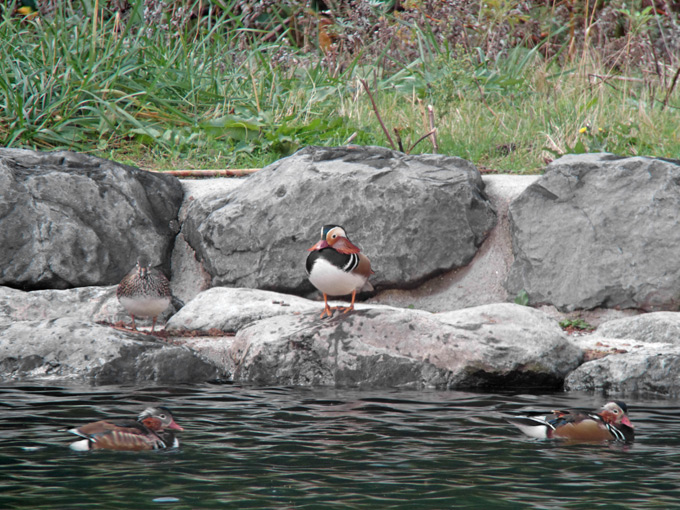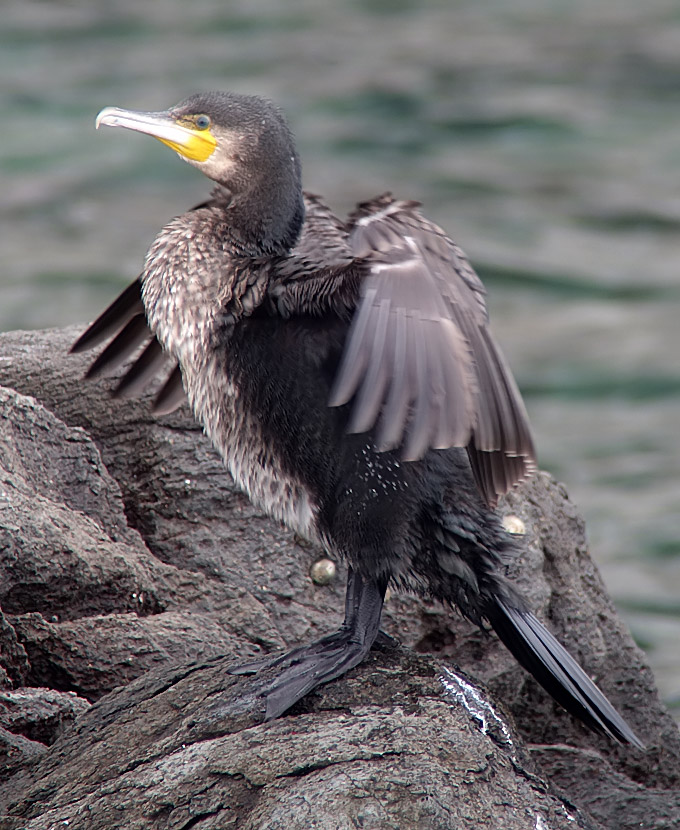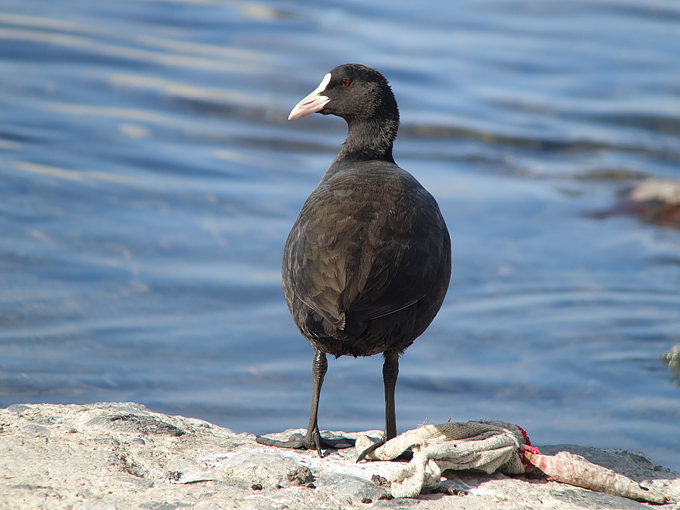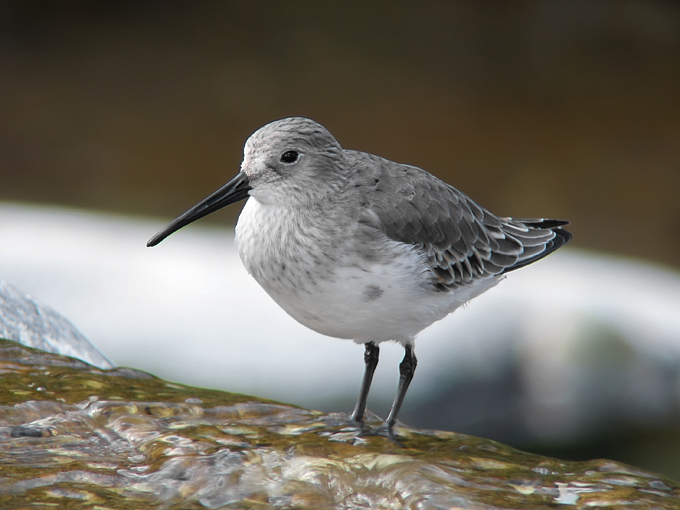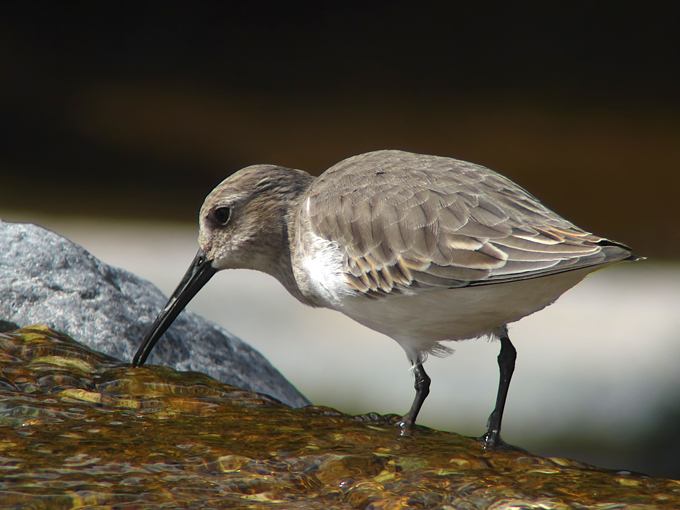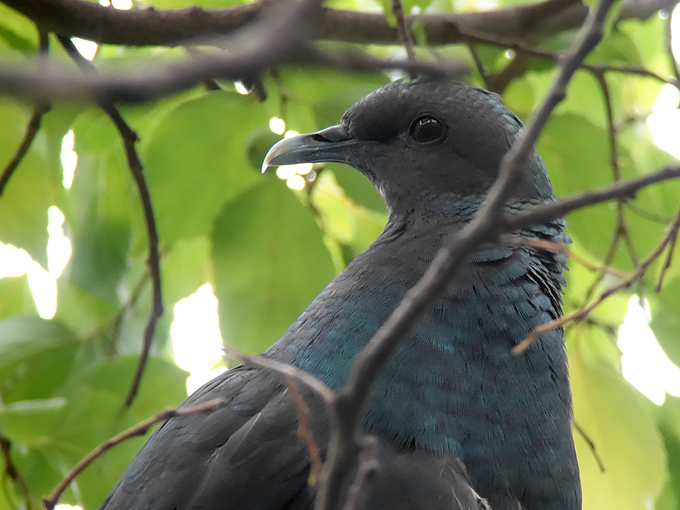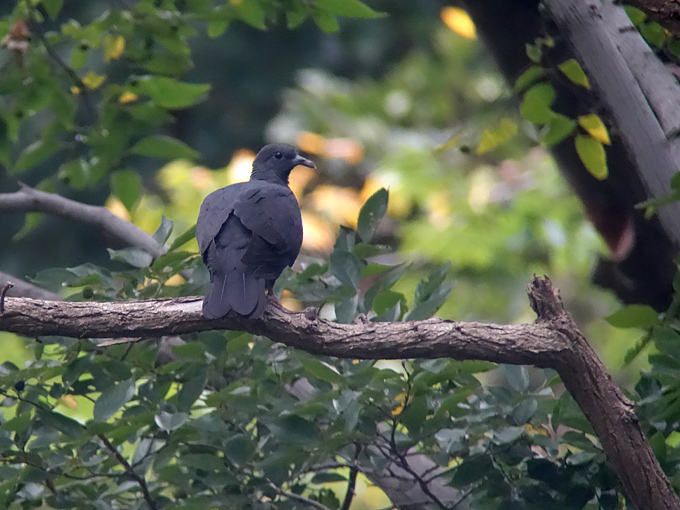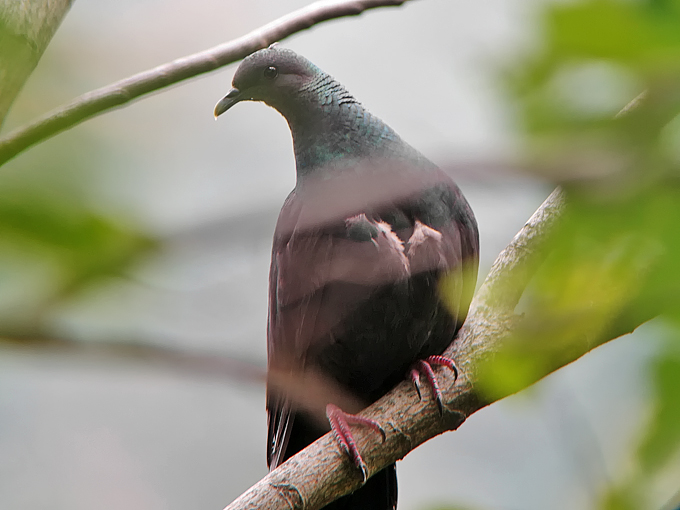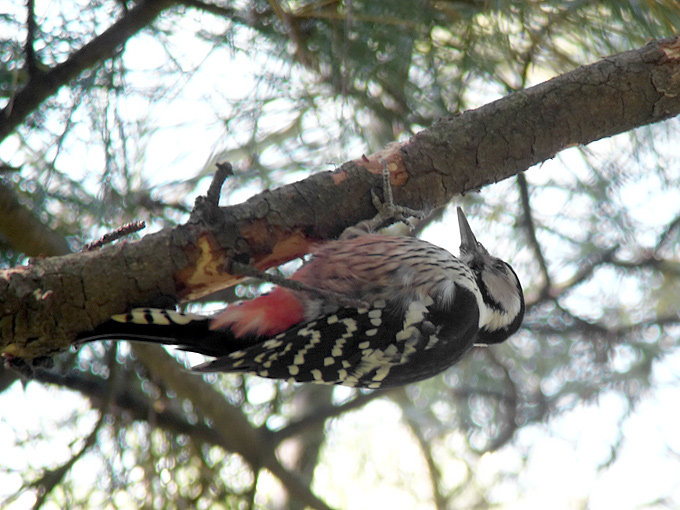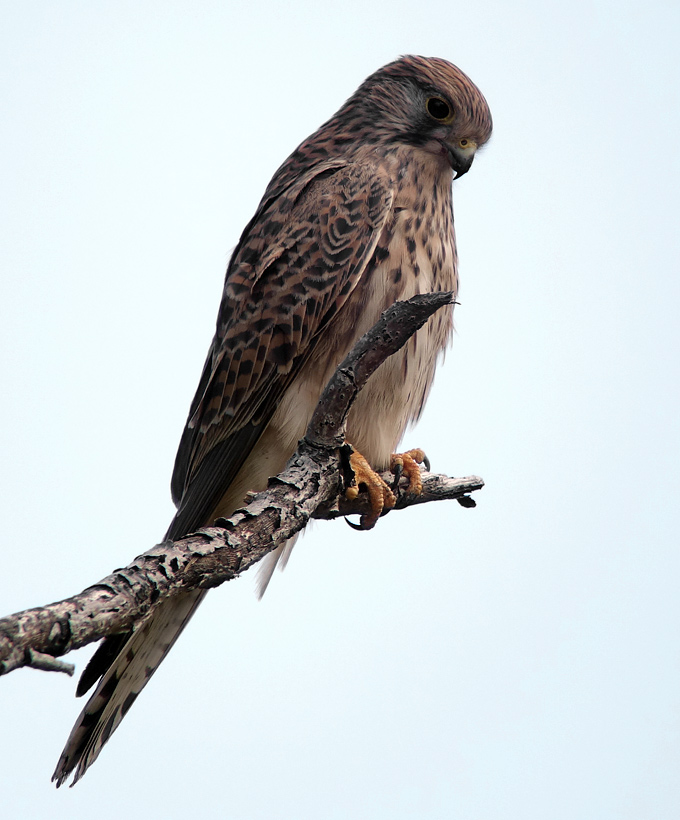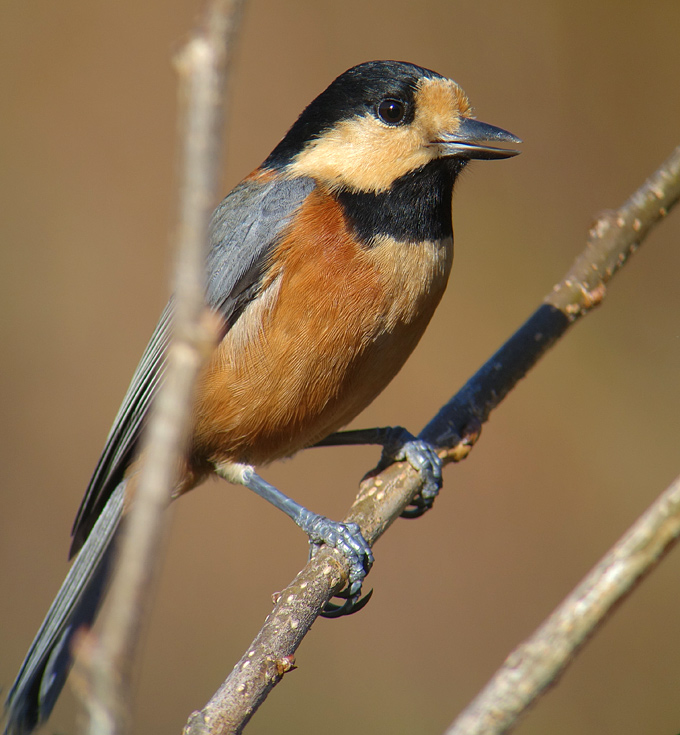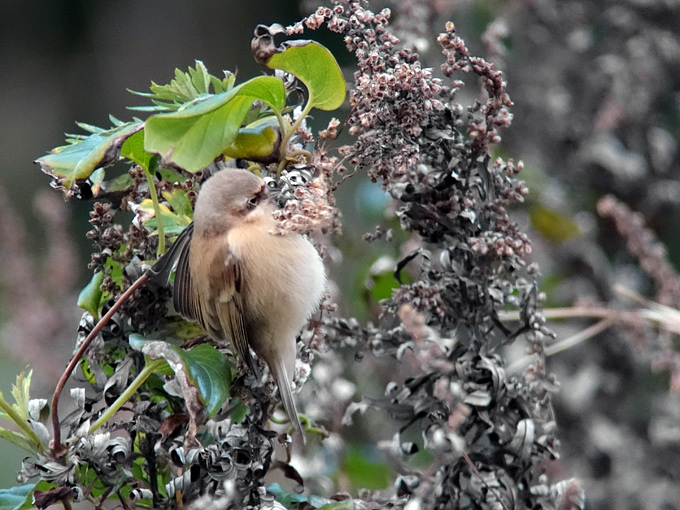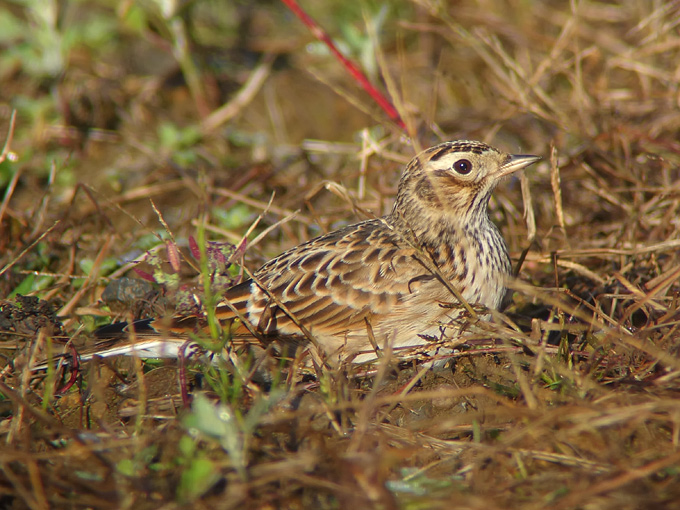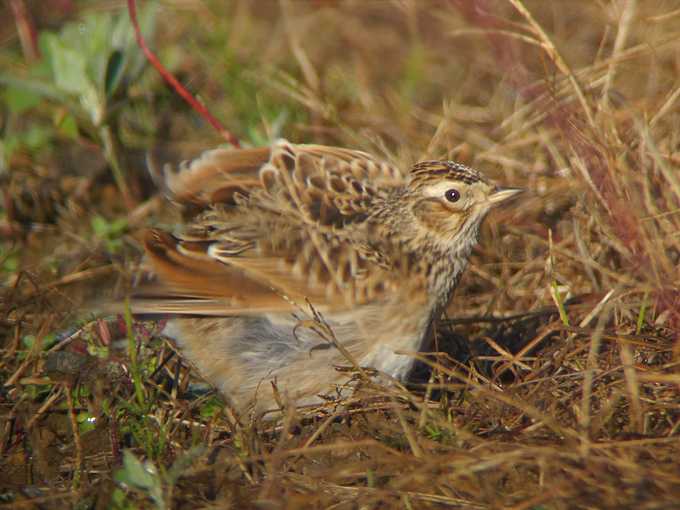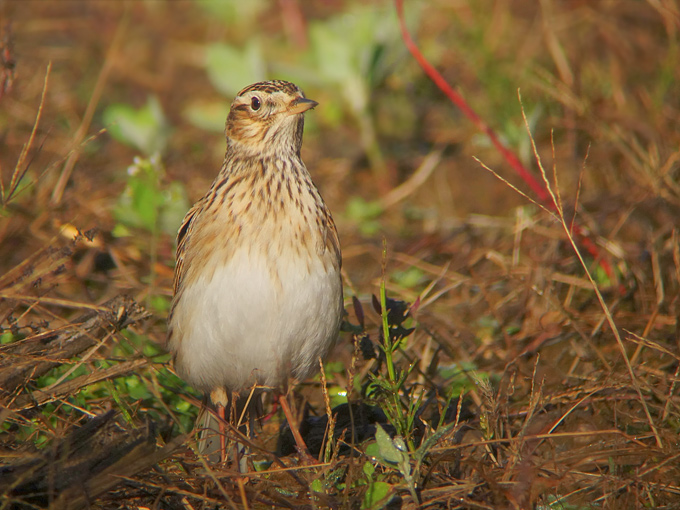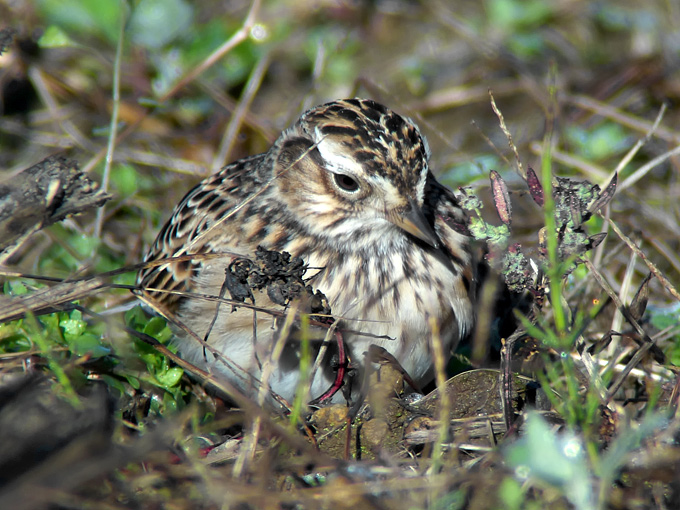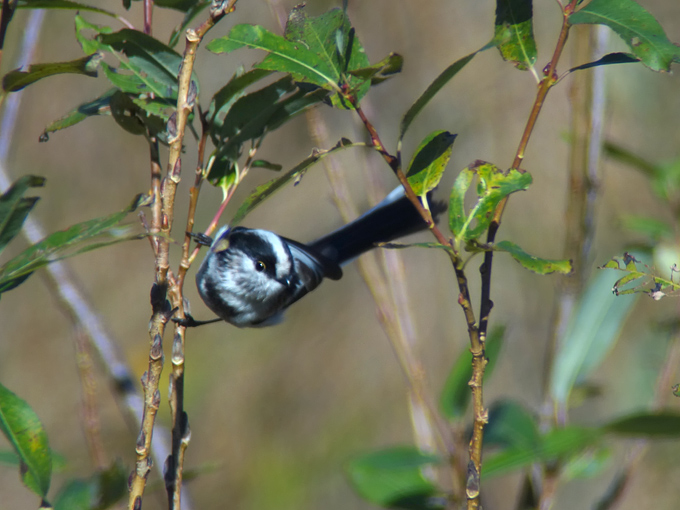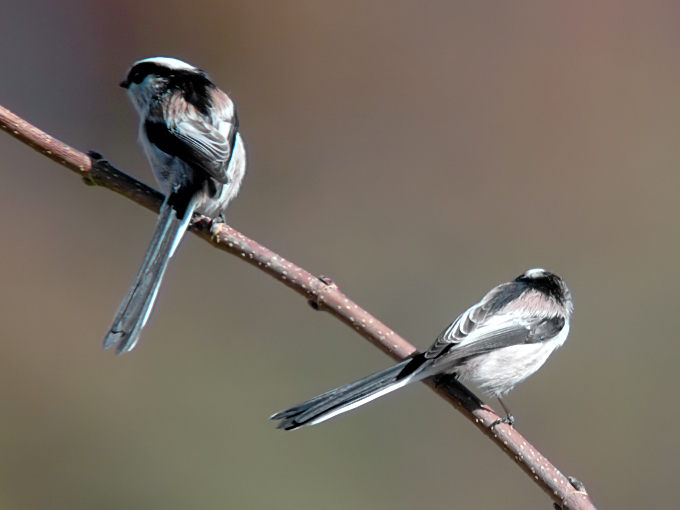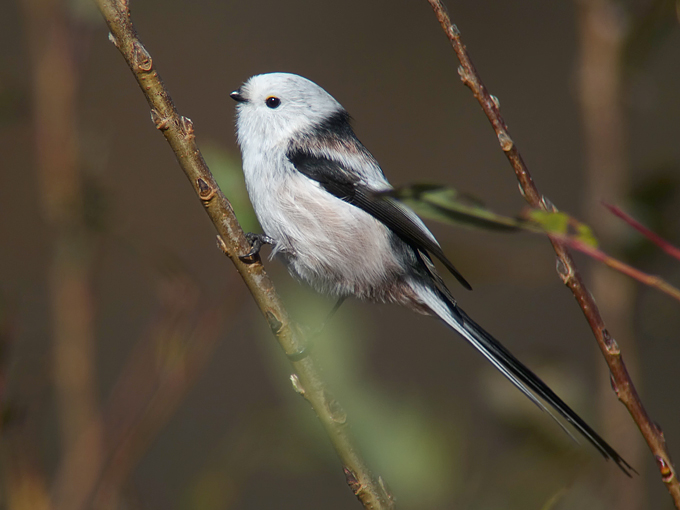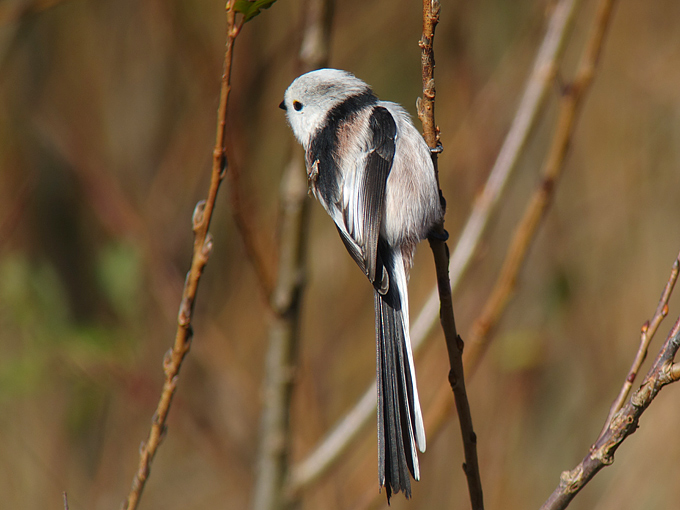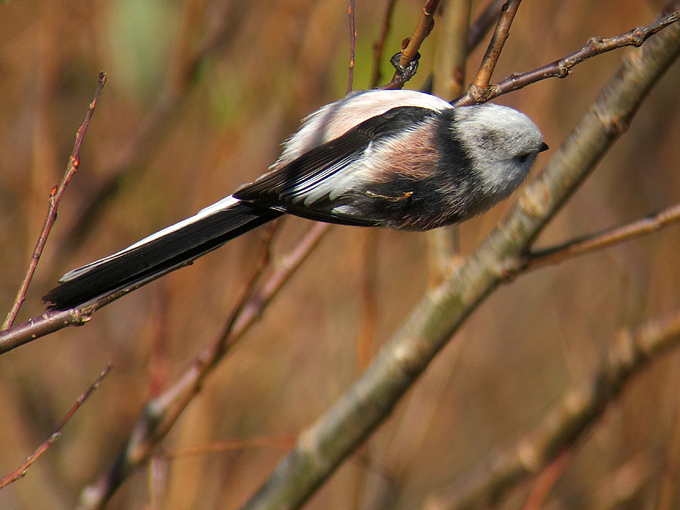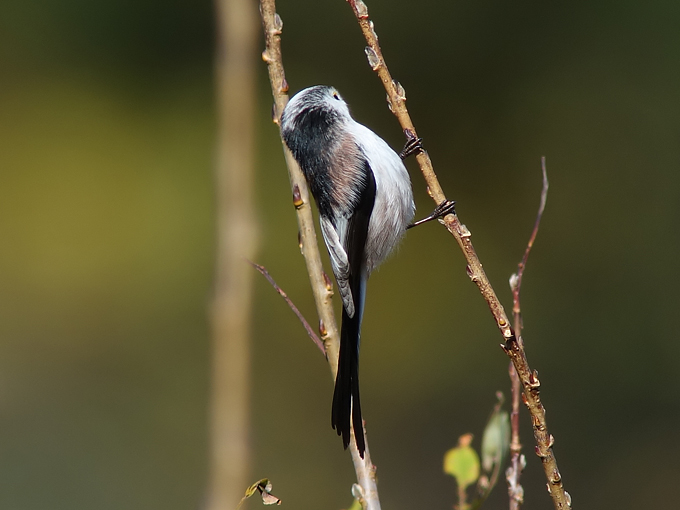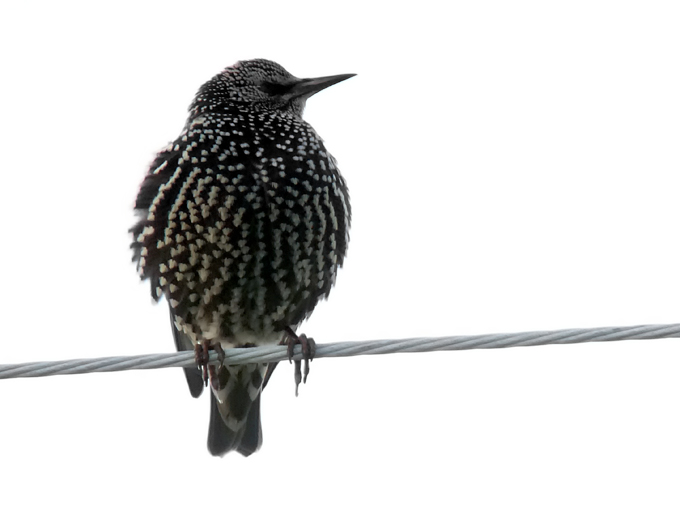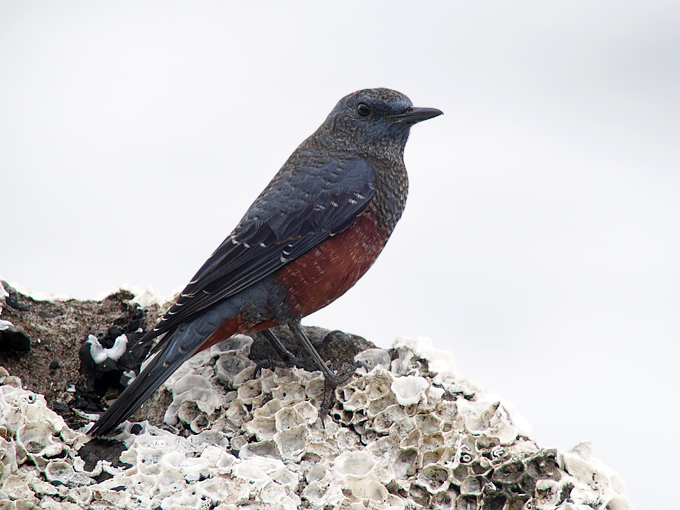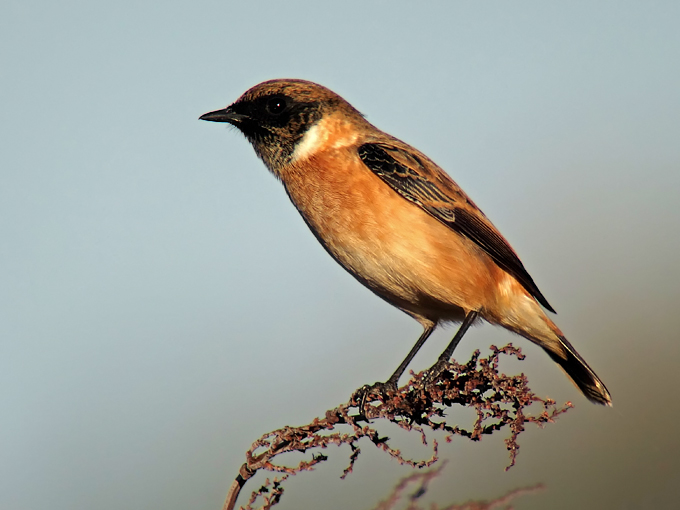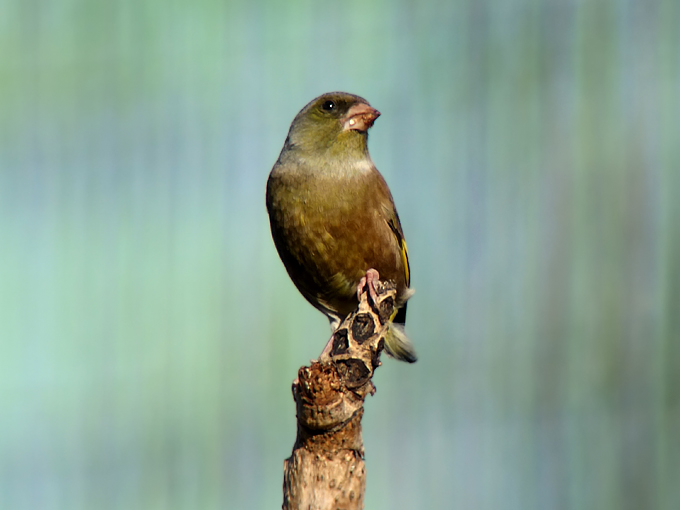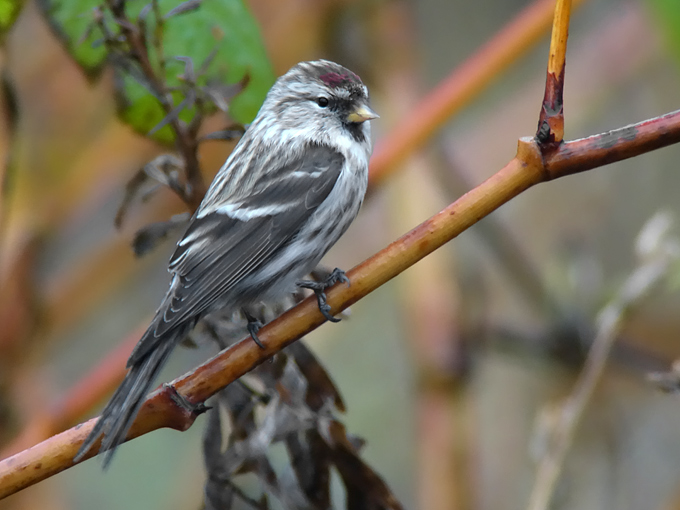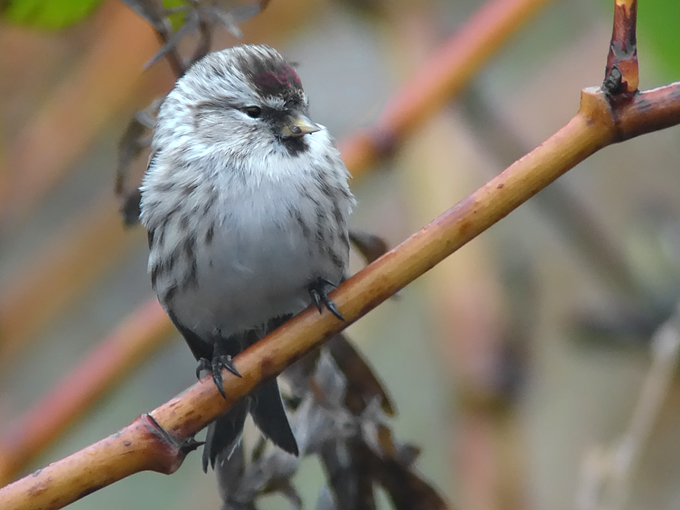 | E-mail to Birds Korea |
 | KWBS |
in the Region
 | The Oriental Bird Club |
 | BirdLife International (Asia) |
November
Waves of colder air and strong winds cause a sharp drop in temperature, especially from mid-month onwards when maxima can be as low as 8-10°C. The last of the autumn migrants are joined by huge numbers of wintering waterbirds.
Numbers of Baikal Teal and other duck and geese species continue to build. Swan Geese peak at the Han-Imjin (with several hundred in recent winters) and internationally important concentrations of Whooper Swan arrive at a few key sites. Movements of loons and alcids, most especially Ancient Murrelet, can be impressive along the east coast (though less so in recent winters), and winter raptors also become more widespread, including Eastern Buzzards from the beginning of the month and Cinereous Vultures from month’s end. November also sees a rapid increase in most gull species, with Saunders’s Gull widespread on remaining tidal-flats, and mixed flocks of Heuglin’s, Vega, Mongolian and Slaty-backed Gulls appearing in harbours, especially on the east coast. Arriving winter visitors range in size from the massive to the diminutive. Hooded, then White-naped and Red-crowned Cranes arrive for the winter – the latter two species concentrated mostly in Cheorwon - along with passerines which include Siberian Accentor and Goldrest. Passerines on the move include many late-migrating summer visitors until the second week of the month, when winter species such as Pallas’s Reed Bunting predominate.
In the past decade, November has produced several national first-records including White-capped Redstart (2003), Redwing (2006) and Fujian Niltava (2010).
Joonam Reservoirs & Western Nakdong Estuary, November 30
In heavy, dull and dark overcast with occasional spells of rain and misty drizzle – a prelude to the end of autumn and the start of real winter weather - a total of 93 species logged. Selected highlights included single adult Lesser White-fronted Goose, Eastern Marsh Harrier (at the Nakdong), male Red-flanked Bluetail and Lapland Longspur (latter heard only: this species appears usually to be genuinely scarce in the southeast of the country); a dozen Baikal Teal, seven White-naped Crane and three Eurasian Hoopoe; a single loose flock of 4,700 Mallard out of c. 6,000 seen during the day; in total perhaps 500+ Oriental Turtle Dove, 150+ Far Eastern and 10+ Eurasian Skylarks, 350+ White-cheeked Starling and c. 20 Common Starling (more evidence of this latter species’ recent increase); and hybrid combinations of two Red-billed x White-Cheeked Starlings (but no pure Red-billeds) and single hybrid Mallard x Eastern Spot-billed Duck and presumed Eurasian Wigeon x American Wigeon.
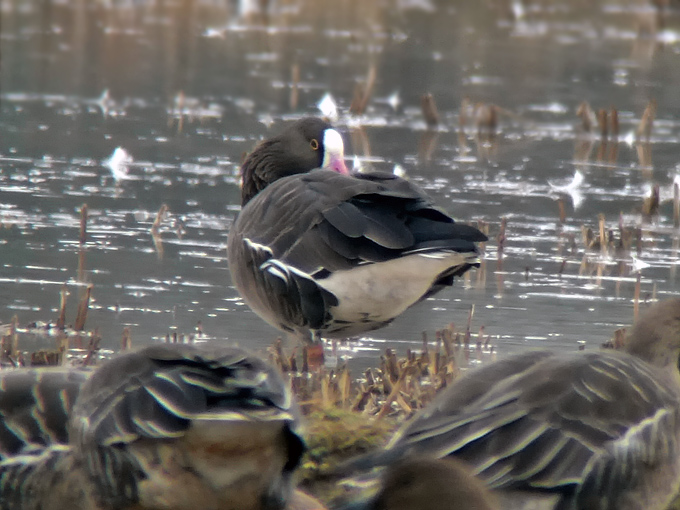
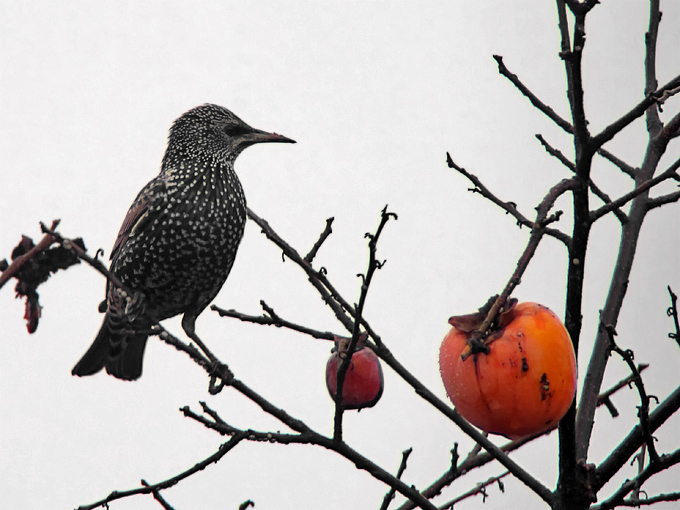
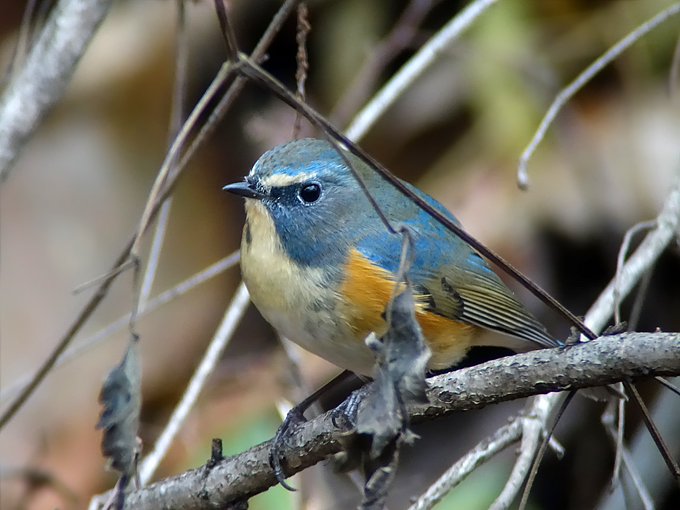
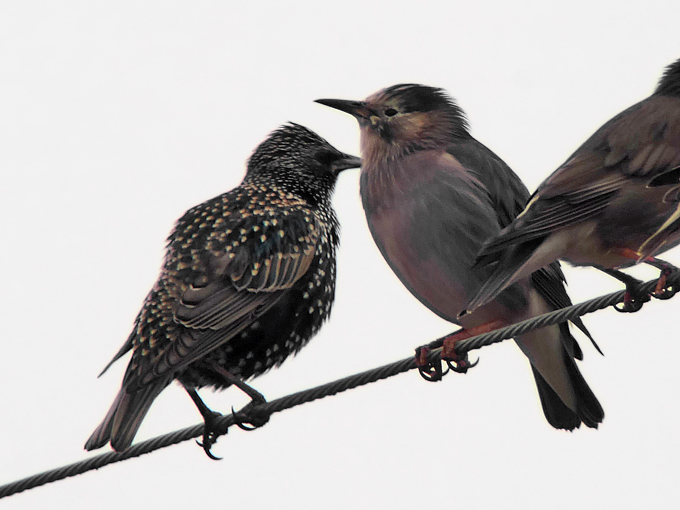
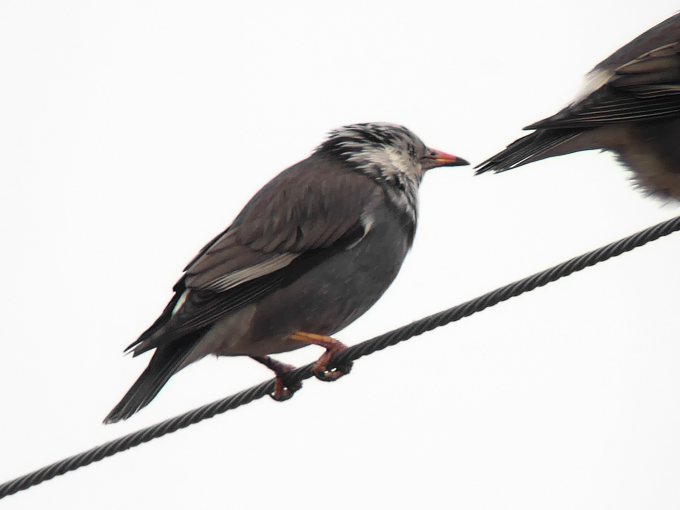
We also enjoyed excellent views of “big-billed” middendorffii Taiga Bean Geese at Joonam. These included one (out of 300+ close birds) with an almost completely dark bill (shown in the image), and another seen more distantly, also with very limited paler orange on the bill sides, unfortunately not digiscoped. Although several online and published sources state that juvenile bean geese can show duller bare part coloration than adults, both of these dark-billed birds help illustrate yet another facet of what appears to be great variation in bill patterning and especially structure shown by middendorffii that overwinter in the ROK. As noted over the years, in addition to presumed male / female differences and individual variation within populations, Taiga Bean Geese appear (to me at least) generally biggest-bodied, biggest-headed and longest-billed in the southeast of the country (often with little bill “grin”), e.g. at Upo, Joonam and in the Nakdong Estuary; apparently thinner-billed and thinner-necked looking at some other sites (e.g. sometimes in the southwest); and often rather closer in appearance to Tundra Bean Goose in the west and northwest (with less slope to the forehead and more of a “grin”), at Saemangeum, the Geum Estuary, Seosan and Baekryeong, where groups of Taiga and Tundra can often be seen side-by-side. Many of these differences in perception might well be down to differences in viewing conditions and distance (best at the Nakdong, worst at Saemangeum). However, might they also be the result of differences in origin of breeding populations and winter feeding ecology, with subtly different feeding opportunities available in different parts of the country in winter, e.g. between the often frozen northwest and the much milder, usually unfrozen southeast? Fellow Birds Koreans: more images of bean geese please!
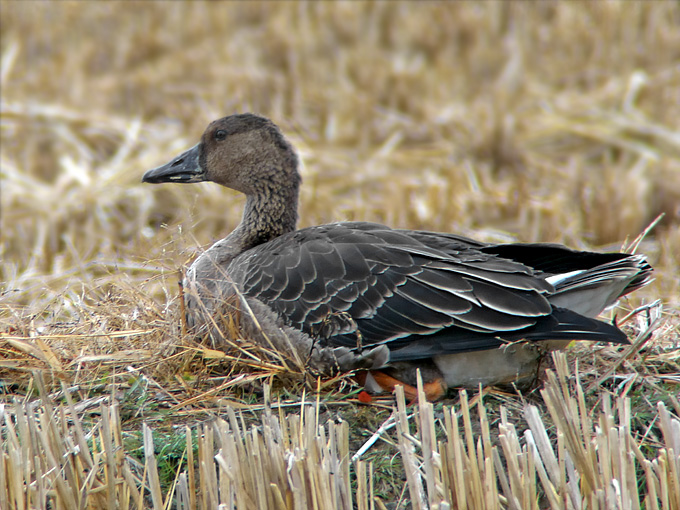
Anyangcheon, November 29
There were about 60 Pintail between Doksan and Anyang today. The males have already completed their moult - earlier than other wildfowl.

Jeollanamdo, November 25
After the strong rain the day before had brought the river visited had largely very brownish color and the water level was rather high. Most numerous species was Eastern Spot-billed Duck with c. 40 individuals all along the observed area. In addition 6 Mallrad, one Common Teal, 3 Common Merganser and 4 Scaly-sided Merganser were seen on the water. Along the river-beds and on some islands more species were observed: 3 Great Egret, 5 Grey Heron, 1 Eurasian Coot, 1 Common Kingfisher, 2 Common Sandpiper, 1 Long-billed Plover, 7 White and 1 Grey Wagtail, 2 Daurian Redstart, 1 Olive-backed Pipitand several of the everywhere present Oriental Turtle Dove, Brown-eared Bulbul and Erasian Magpie.
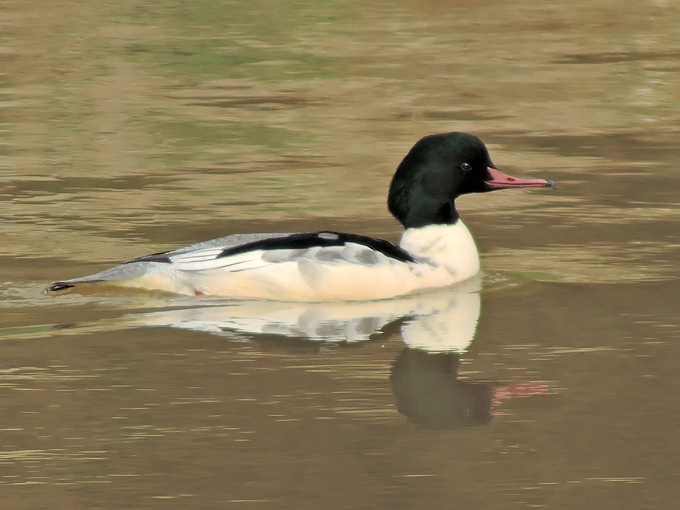
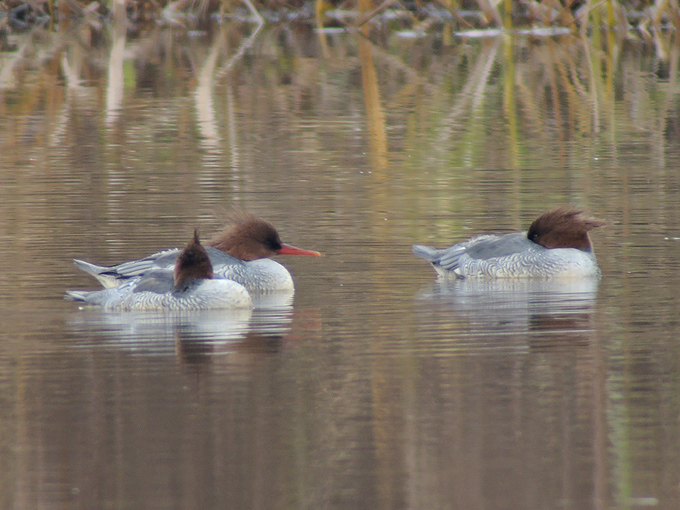
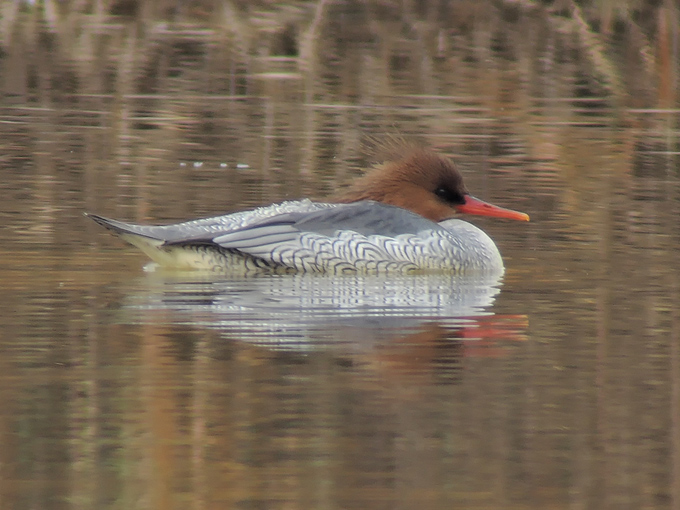
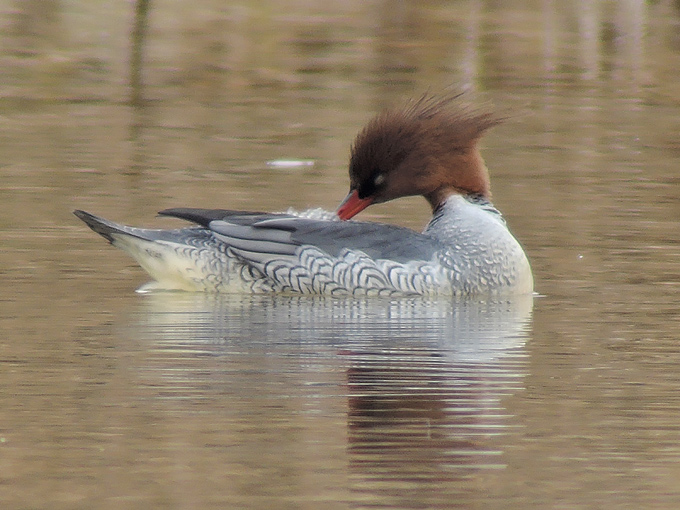
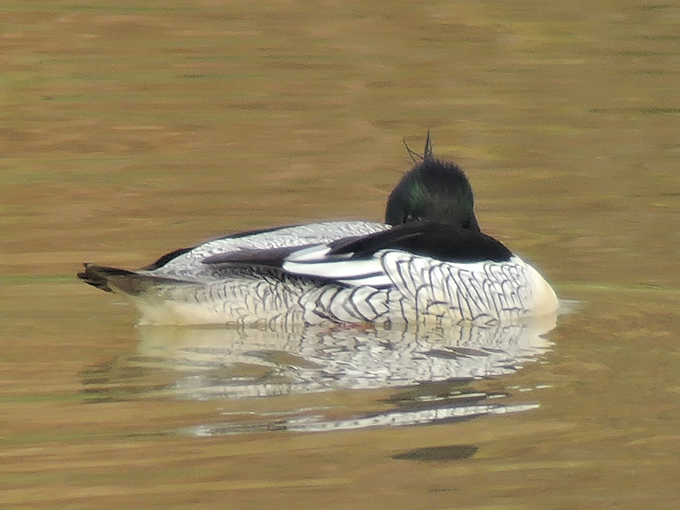
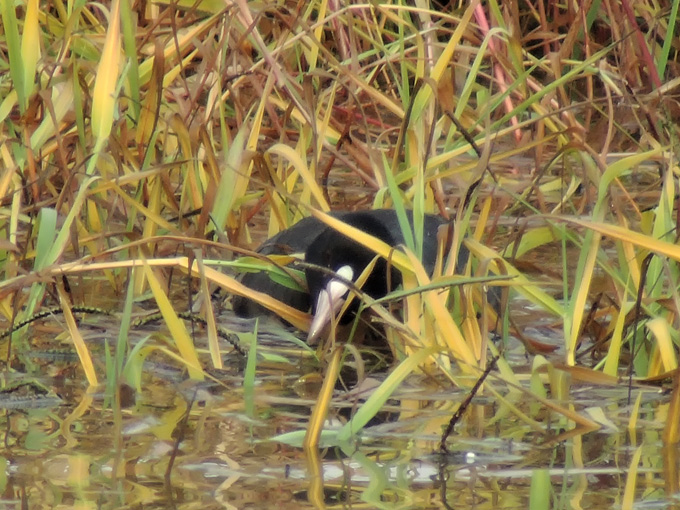
Yeongsan barrage Mokpo, November 23
Before the walk in the afternoon along the waterfront ended with light rain, several species were seen the first time this autumn: 2 Great Crested Grebe, 1 Little Grebe, 2 Black-necked Grebe and a flock of c. 20 Black-headed Gull. Also seen several Black-tailed Gull, c. 20 Eastern Spotbilled Duck, 9 Great Cormorant and one Common Sandpiper.
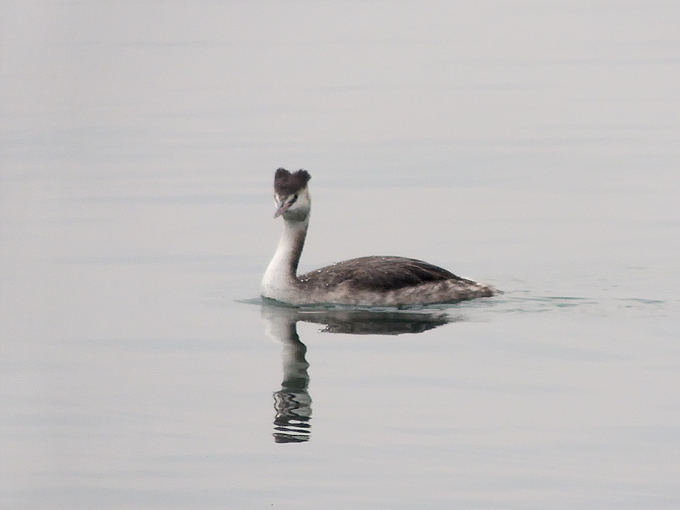

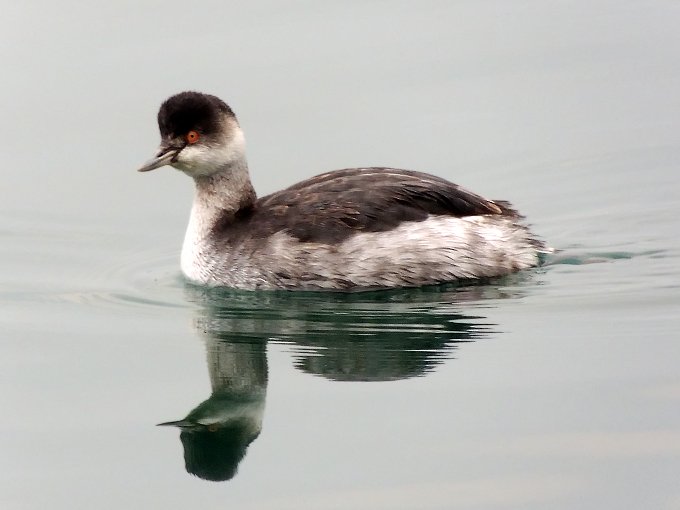
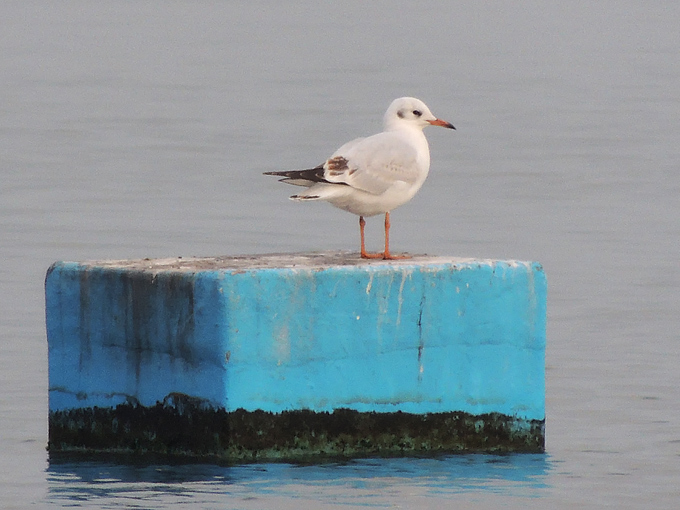
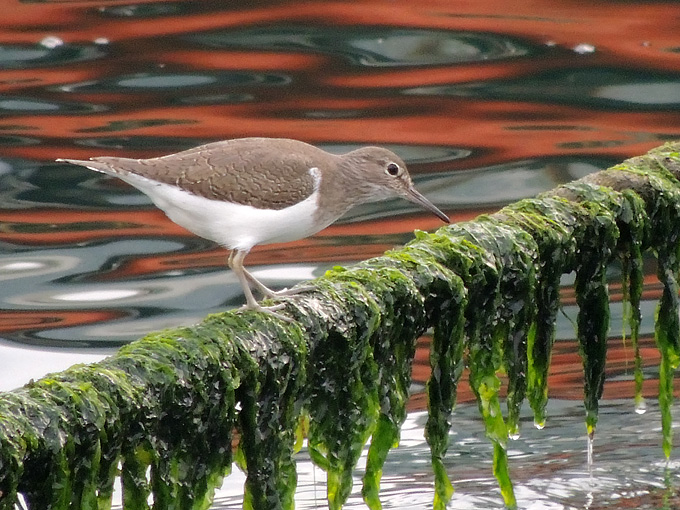
Junam Reservoir, November 22
Had a stop at Junam for some quick birding in the morning to see if any of the crane species had arrived. I didn't find any but was excited to see two Chinese Grosbeak and three Yellow-bellied Tit. There are also reports of three regularly-observed Yellow-bellied Tit in the Jinju area. I wonder if there will be increased sightings this winter.
Gangwha-do, November 22
Despite morning rain and on-and-off fog, a good day for raptors: several Kestrels, a Peregrine, 4 Eastern Buzzards, 2 or 3 Upland Buzzards including a handsome dark-phase, and one possible vulpinus or Steppe Buzzard first found a week earlier by Mr. Kim Seog-min. Other birds: cracking looks at 53 Swan Geese, scattered flocks of Bean and White-fronted Geese (more of the latter), 2 Common Pochards, 18 Eastern Spot-billed Ducks, 5 Mallards, a lone White-naped Crane, several (heard) Far Eastern Skylarks, c. 50 Oriental Greenfinches, a few Yellow-throated Buntings, a Daurian Redstart, 2 Grey-headed Woodpeckers and several Pheasants.
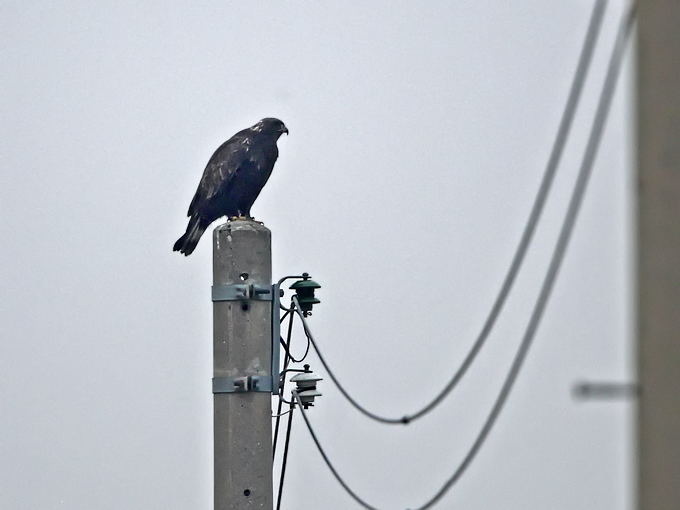
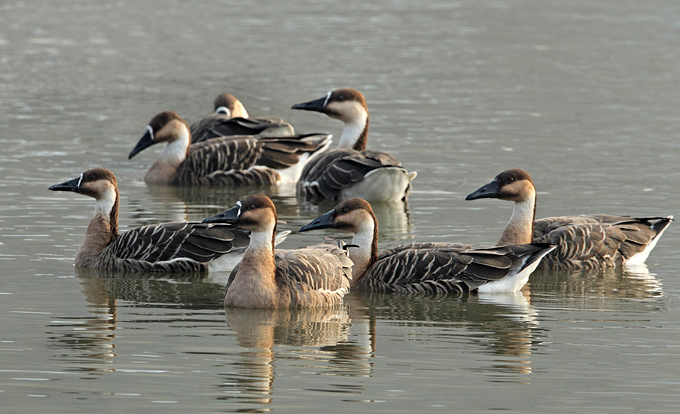
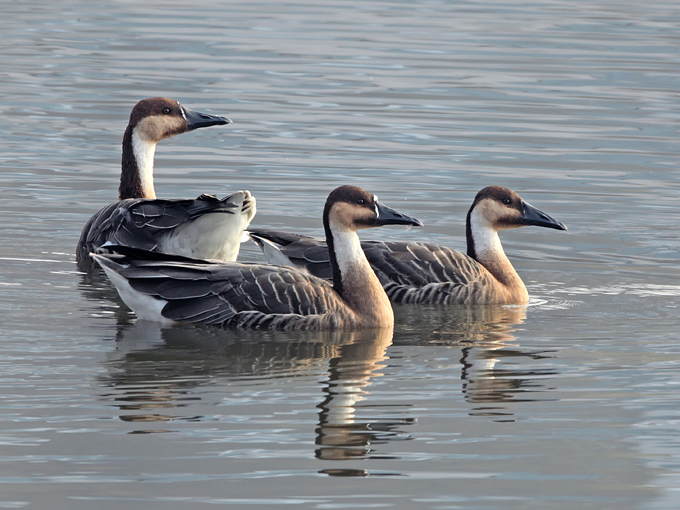
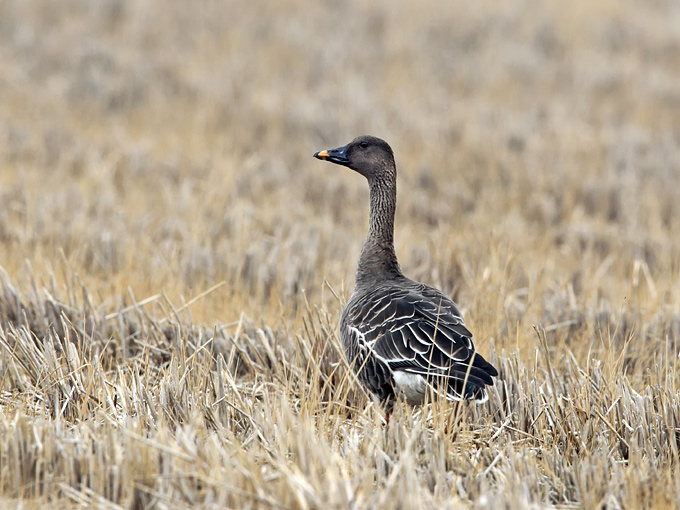
National Arboretum, November 21
A somewhat quiet day: (other than bulldozing horns in the north corner and small-group loudspeaker tours) with an overall feel of small numbers. 1 Wren, 40 Yellow-throated Buntings, scattered Great, Marsh, Long-tailed and Varied Tits, only 1 Eurasian Nuthatch, 4 Naumann’s Thrushes, 1 White’s Thrush, 1 Common Kingfisher, 1 Solitary Snipe glimpsed flying downstream, 1 Eurasian Bullfinch, at least 29 Mandarin Ducks, a Grey Heron, a Eurasian Kestrel, scattered small flocks of Bramblings, several White-backed, 1 Great Spotted, 1 Grey-headed and a few Japanese Pygmy Woodpeckers, 1 Japanese Wagtail. Also in the trees: several lithe and acrobatic Squirrels.
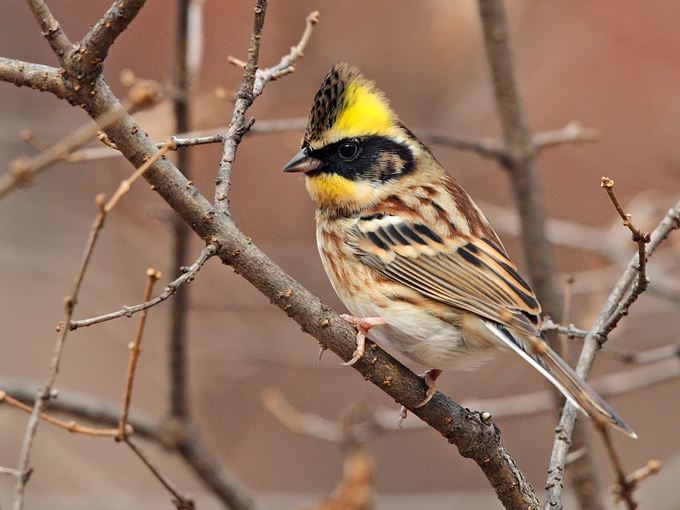
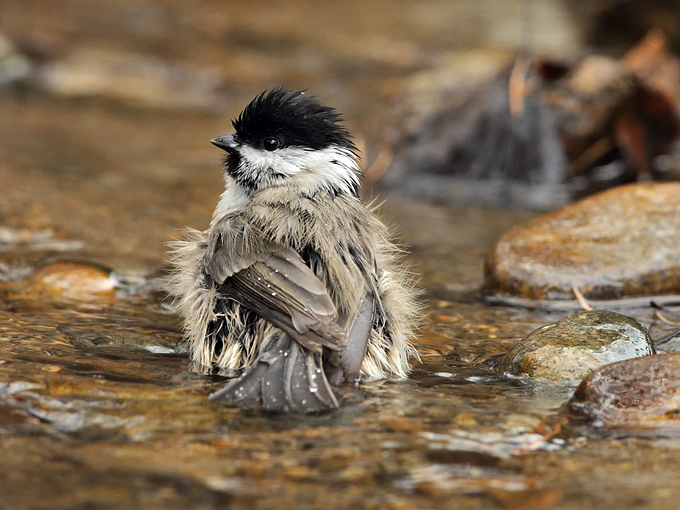
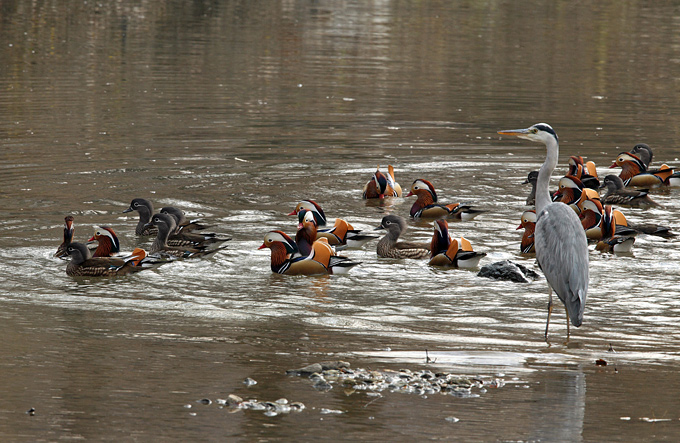
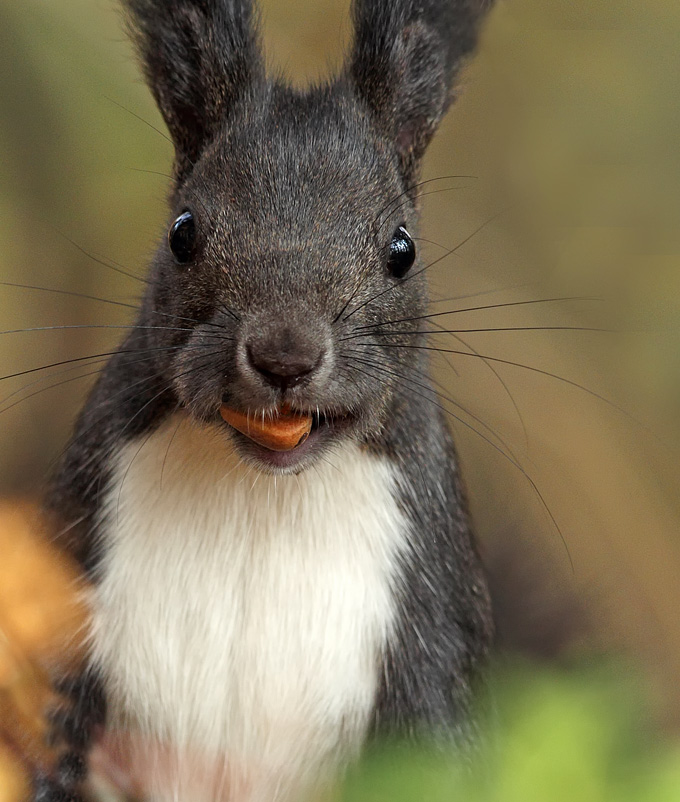
Igidae, east Busan, November 21
In still-mild and autumnal conditions (with a day of sunshine, light winds and a low of 9C rising to 17C or 18C in the afternoon) another day was spent walking the trails in Igidae. As might be expected, there was much overlap in species and numbers with earlier in the week, though with only one Red-flanked Bluetail, but an increase in Light-vented Bulbul and Grey Bunting (both to five), Brown-eared Bulbul (to 150, including a single flock of 80), and Siberian Accentor, with probably 6+ logged during the day.
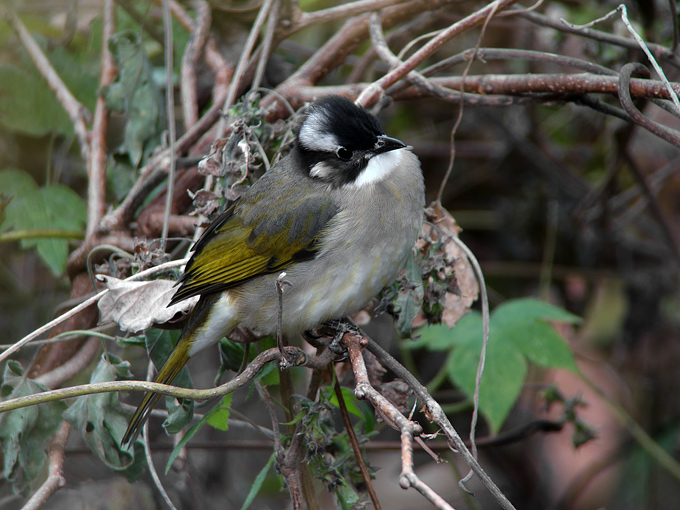
Only two of these accentors were seen well, revealing in brief side-by-side views and in the images tremendous differences in plumage saturation. According to Lars Svensson’s Fourth Edition of Identification Guide to European Subspecies, “adults = First years on plumage”, with a complete summer moult in adults; and only worn breeding birds, presumably pre-moult, look paler in e.g. the supercilium, with darker spotting on the breast feathers. According to the same text, north-eastern badia is “somewhat darker on crown than nominate” and “more rufous-tinged on mantle and scapulars”. Brazil’s Birds of East Asia field-guide confusingly illustrates First-years as paler than summer-plumaged adults, while the text adds that badia is “smaller and darker, with richer chestnut mantle, deeper ochre underparts and more strongly rufous flank streaks” than the more southern-breeding nominate subspecies.
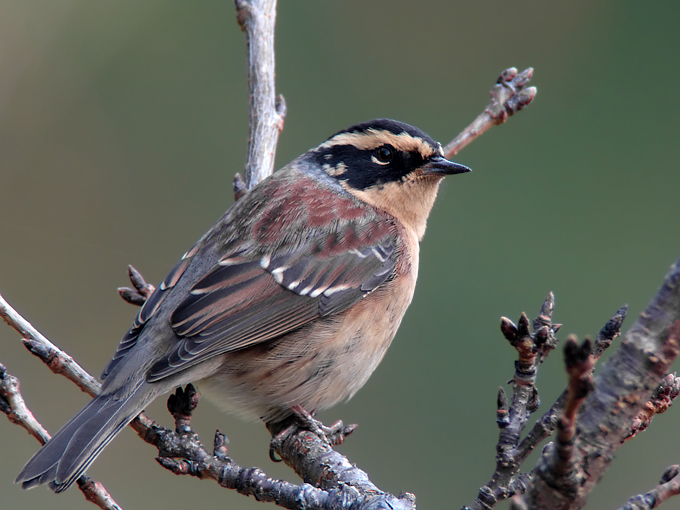
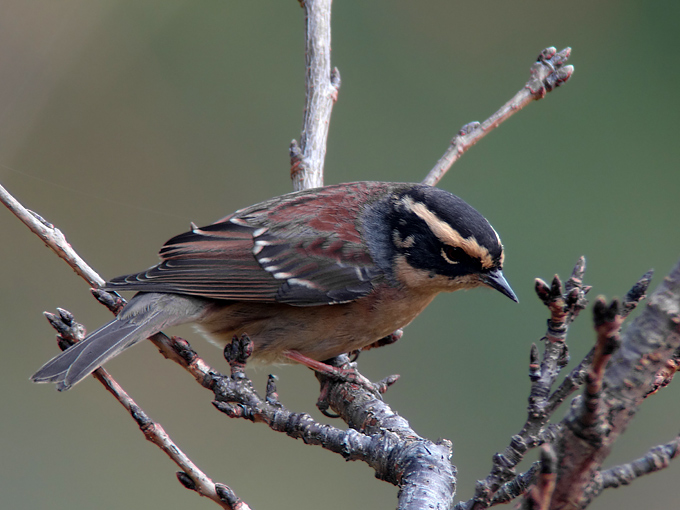
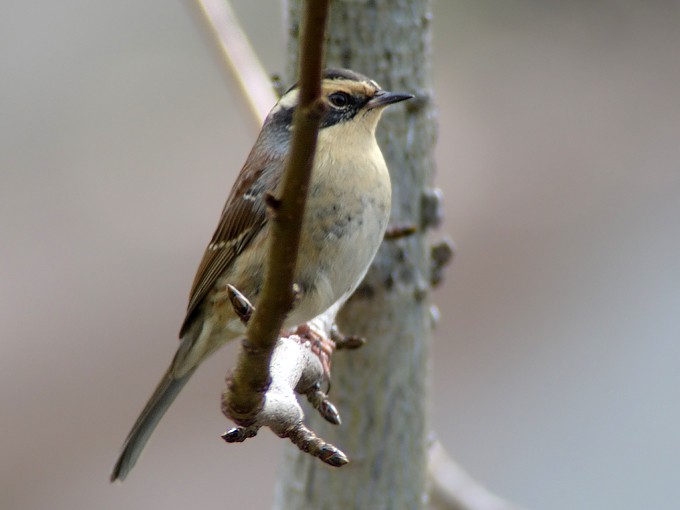
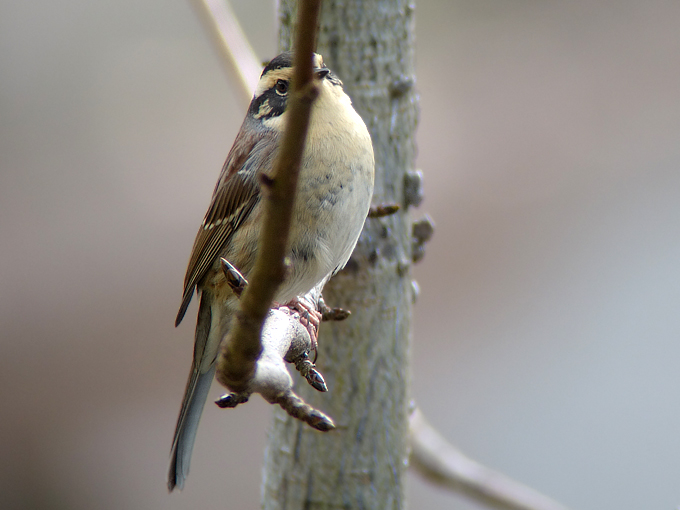
Other species of note included a flock of 16 Mandarin Duck (out on the sea), carrying with them a single Baikal Teal and a single hybrid Mallard x Eastern Spot-billed Duck; single White’s Thrush and Yellow-bellied Tit; and heard only, 3-4 Eurasian Bullfinch, and one or two Tristram’s and Black-faced Buntings.
Oddest for the day (and actually a welcome sight to this vegetarian’s eyes!) was a Bull-headed Shrike seen feeding on berries, or much less likely on insects that were on the berries. The bird hung almost upside down bulbul-like to access berry-clumps three times in probably five minutes. Each time, it plucked at and swallowed something, before eventually perching up in the same tree to “cough-up” a large pellet. A quick google search reveals that other shrike species have been recorded eating fruit, especially in times of food shortage (see e.g. http://www.besgroup.org/2014/01/24/tiger-shrike-eats-bridelia-tomentosa-fruit/). However, it appears that there is still likely to be plenty of food available for a Bull-headed Shrike to feed on – with several large insects still on the wing, a small rodent heard, and probably 400 Vinous-throated Parrotbills logged during the day etc. Has anyone seen Bull-headed Shrike feeding on fruit before, and does anyone know the name of the berry-laden plant in the image please? Thank you in advance!
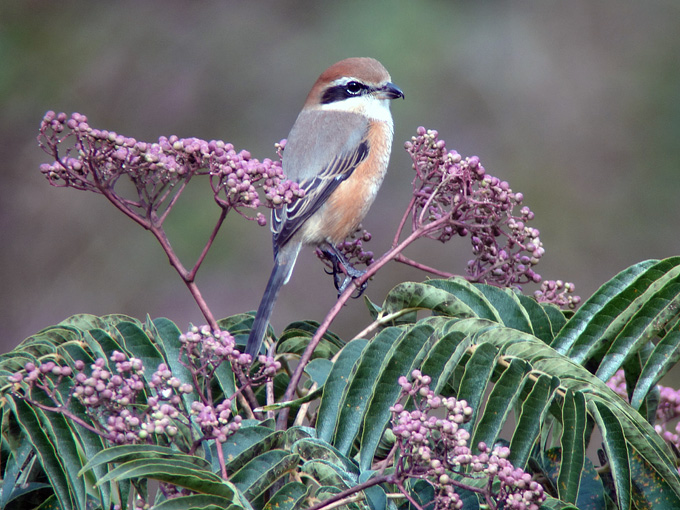
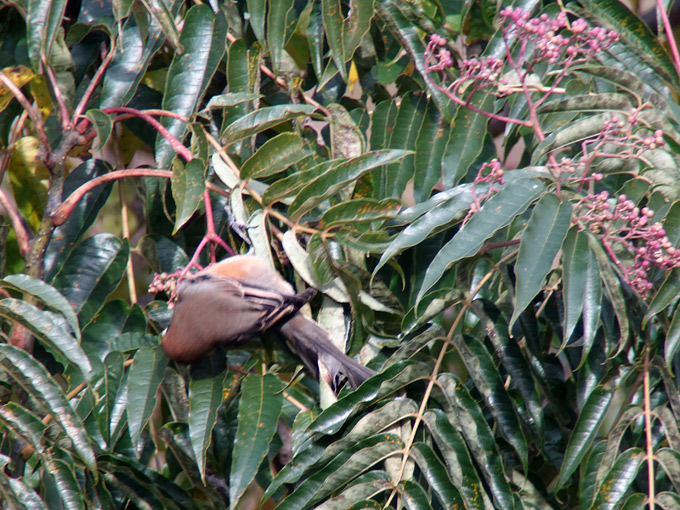
Gangjin Bay, November 20
The Gangjin Bay in the morning with clear and sunny weather was the destination of today's trip. At the end of the bay c. 1200 Whooper Swan, c. 400 Eastern Spot-billed Duck and c. 500 Mallard where scattered all over the sides where the running out tide uncovered the mud. In addition c. 40 Great Egret, c. 30 Little Egret and c. 60 Grey Heron were also seen, of the latter also smaller groups on the adjacent rice fields. Two groups of Common Megranser, 37 in total, were observed, one group swimming/diving bay outwards and one at the bay's end. But only a handful of Black-tailed Gulls and one presumed Mongolian Gull were seen.
Non waterbirds were seen in the fields, reedbeds and other vegetation beside the bay: one female Common Pheasant, a flock of Azure-winged Magpie crossing a road into trees of which only the last 5 individuals were observed, Eurasian Magpie and Brown-eared Bulbul heard and seen everywhere around the bay, in one reed-bed a fock of c. 50 Eurasian Treesparrow and a flock of c. 15 Vinous-throated Parrotbill, two Bull-headed Shrike and 9 Olive-backed Pipit.
A surprise was the appearance of a Band-winged Grasshopper in this late November; the field guide mentions occurrence only between July and October.
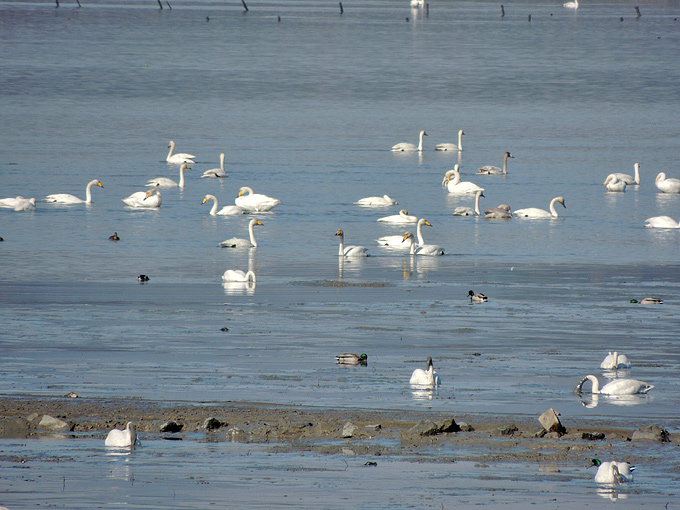
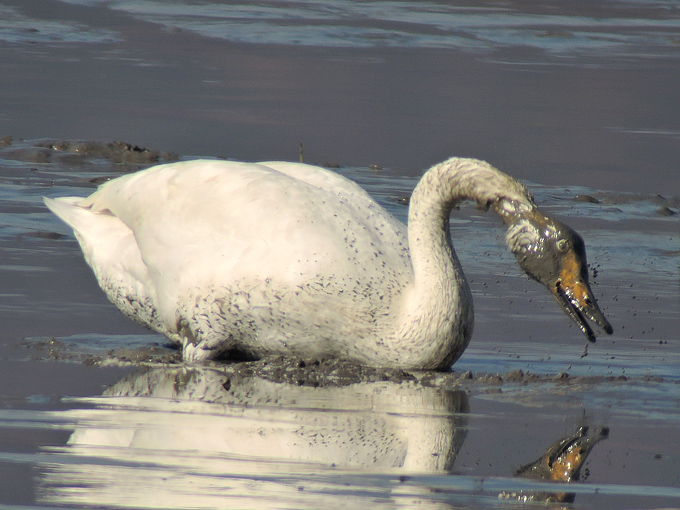
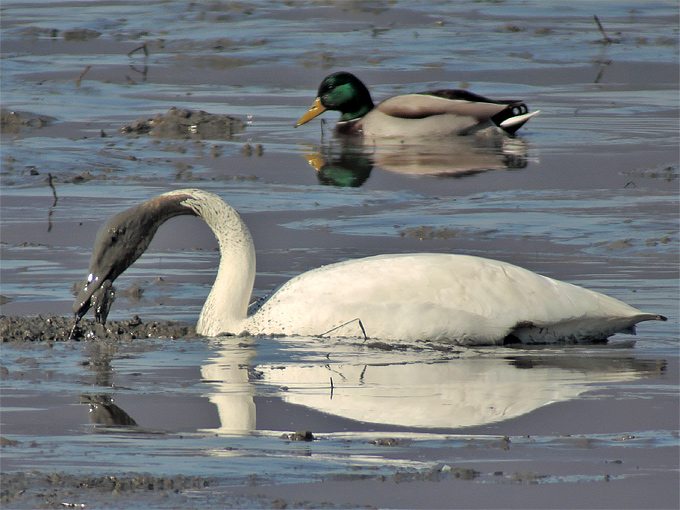
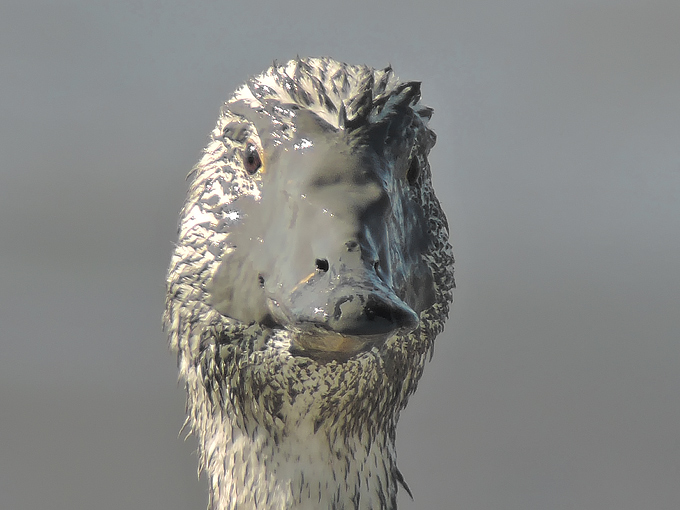
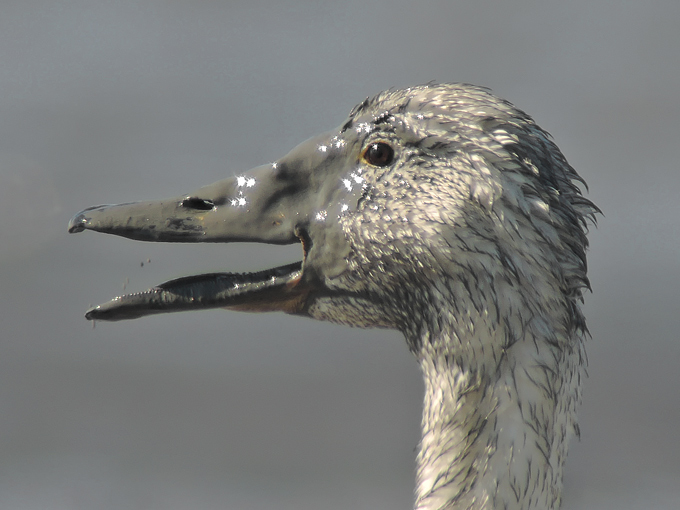
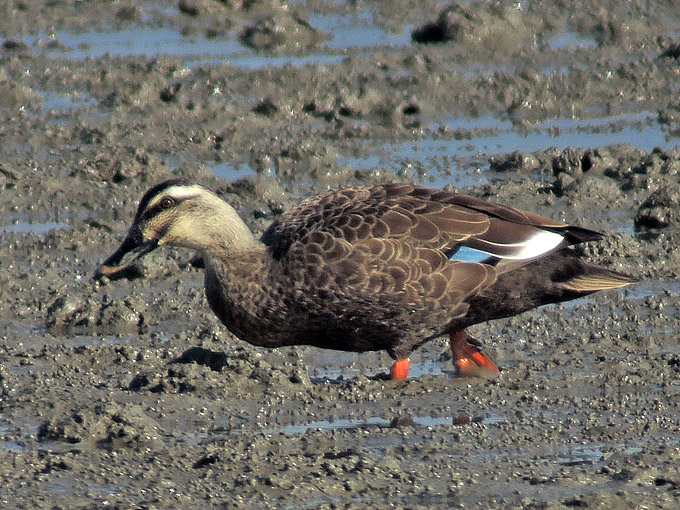
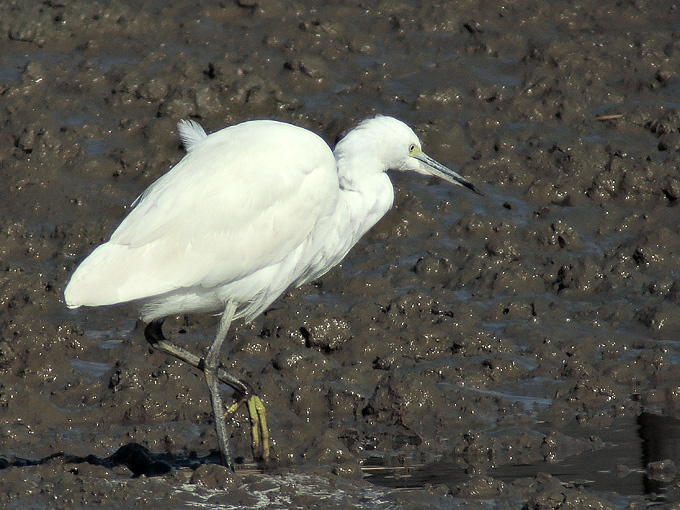
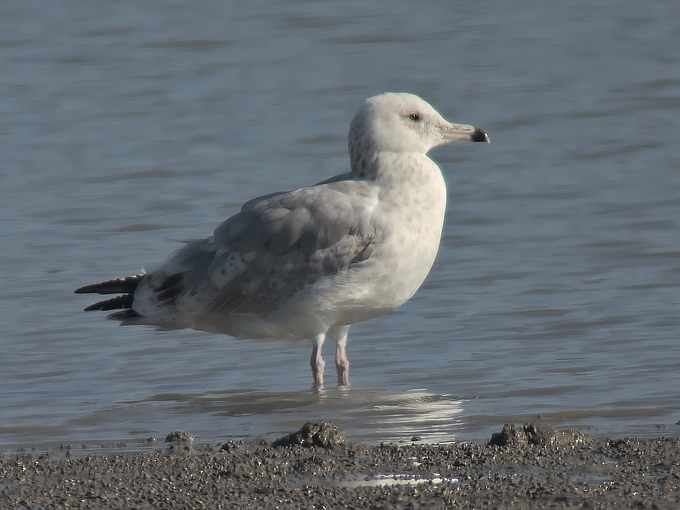
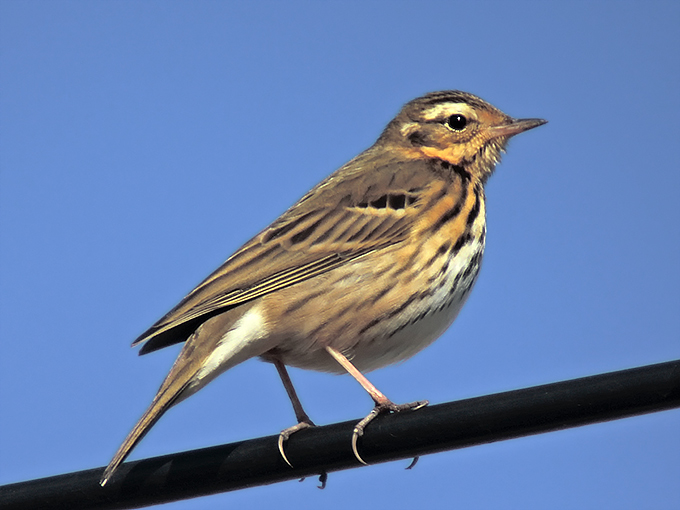
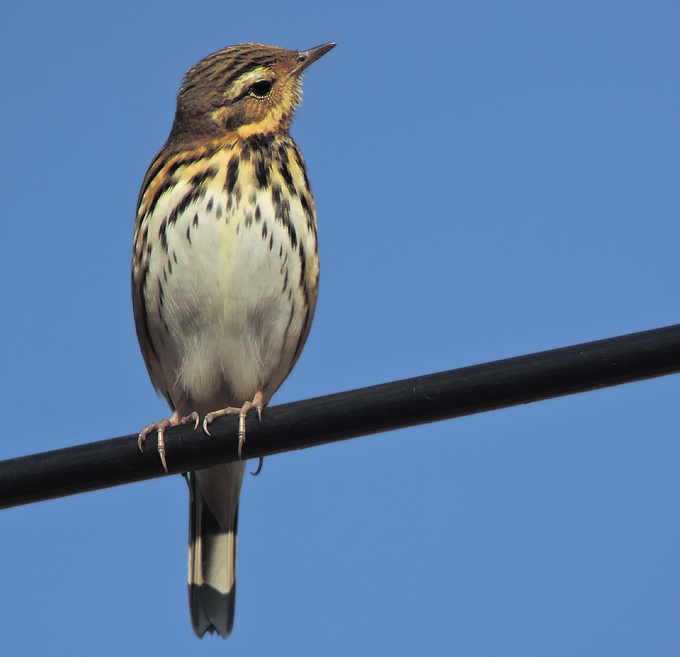
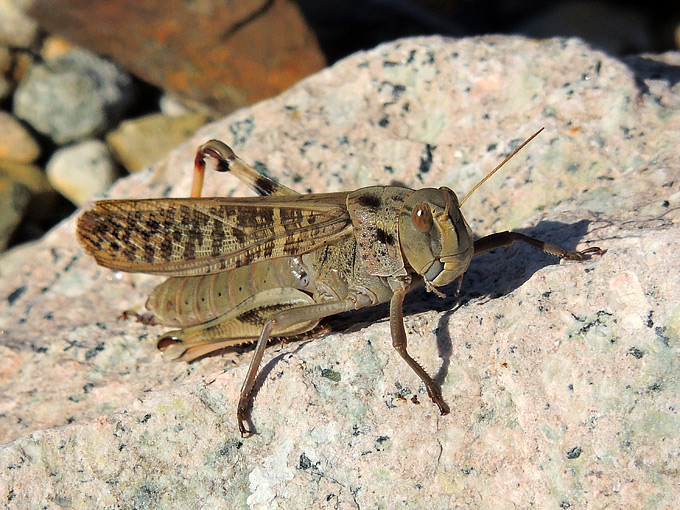
Igidae, east Busan, November 11 and 17
Three hours were spent in the local park on the 11th (covering c. 5km of trails) followed by ten hours there on the 17th, covering c. 9km of up-and-down trails. Weather on both dates was sunny, with a light westerly wind (F1-3), rather cooler on the 17th with temperatures at 0730 of c.7°C rising to a high of 14°C during the day. A total of 52 species were logged on the combined dates, including a few interesting records.
- Common Pheasant Phasianus colchicus. Probably five.
- Temminck’s Cormorant Phalacrocorax capillatus. At least 20 on the 11th and 5 on the 12th, including several birds gaining height on the 11th. Two or three flocks containing 1800+Cormorants flying SW from Oryeok on the 11th were either Temmick’s or Great (or a mix of the two species).
- Japanese Sparrowhawk Accipiter gularis. One on the 11th.
- Eurasian Sparrowhawk Accipiter nisus. Five on the 11th and one on the 17th.
- Black Kite Milvus migrans. One on the 17th.
- Eastern Buzzard Buteo japonicus. One on the 11th and one on the 17th.
- Black-headed Gull Chroicocephalus ridibundus. About ten on both the 11th and 17th.
- Black-tailed Gull Larus crassirostris. Fifty on the 11th and five on the 17th.
- Vega Gull Larus vegae. Thirty on the 11th and five on the 17th.
- Slaty-backed Gull Larus schistisagus. Two on the 17th.
- Oriental Turtle Dove Streptopelia orientalis. 10+ on the 11th; two on the 17th.
- Japanese Pygmy Woodpecker Dendrocopos kizuki. Probably ten on both dates.
- White-backed Woodpecker Dendrocopos leucotos. One on the 11th and two on the 17th. Yet again, the impression is that these birds are noticeably stronger in the neck and bill than birds seen on Ulleung, with much more white in the upperparts.
- Great Spotted Woodpecker Dendrocopos major. Singles on both dates.
- Common Kestrel Falco tinnunculus. One on 11th.
- Peregrine Falcon Falco peregrinus. Two on 11th.
- Bull-headed Shrike Lanius bucephalus. Three on the 17th, including one preying on a parrotbill, taken from near the ground at a pre-roost.
- Eurasian Jay Garrulus glandarius. Three on the 11th and two on the 17th.
- Eurasian Magpie Pica pica. Present on the 11th and probably 25 on the 17th.
- Large-billed Crow Corvus macrorhynchos. Four or five on both dates.
- Coal Tit Periparus ater. Probably 10 on the 11th and 30+ on the 17th (with much larger area covered on the latter date).
- Varied Tit Sittiparus varius. Probably ten on the 11th and 30 on the 17th, including one roosting in a street lamp. All birds that were seen well on both dates looked smaller- and blunter-billed than birds on Ulleung; showed clean orange and blue plumage tones, i.e. showed no admixing of rufous-orange into the upperpart blue; showed obvious paler creamy-rufous areas on the head, breast, and in many cases through the central breast and belly; and showed paler cream-rufous “spurs” when seen head-on.
- Marsh Tit Poecile palustris. Two on the 11th and five on the 17th.
- Eastern Great Tit Parus minor. Perhaps 30 on the 11th and 75 on the 17th. None gave the Marsh Tit-type call heard on Ulleung earlier in the month.
- Far Eastern Skylark Alauda japonica. One heard on the 17th.
- Light-vented Bulbul Pycnonotus sinensis. Two on the 17th. Personal third record of this species in Busan, with previous records being singles in the Nakdong Estuary and in Igidae.
- Brown-eared Bulbul Hypsipetes amaurotis. Probably 50 on the 11th and 100 on the 17th, including one group of 27 seen to head south on the latter date.
- Japanese Bush Warbler Horornis diphone. Two on the 11th and three on the 17th.
- Long-tailed Tit Aegithalos caudatus. 20+ on the 11th and 50+ on the 17th.
- Vinous-throated Parrotbill Sinosuthera webbiana. 30+ on the 11th and >300 on the 17th, including one pre-roost of c. 150 birds.
- Japanese White-eye Zosterops japonicus. Twenty on the 11th, when seven gained height to depart south before dropping back into cover, and c.30 on the 17th.
- Goldcrest Regulus regulus. Probably 15 on the 11th and 50+ on the 17th.
- Eurasian Wren Troglodytes troglodytes. Three on the 11th and probably 15+ on the 17th, including two birds singing at each other.
- White’s Thrush Zoothera aurea. One on the 17th.
- Pale Thrush Turdus pallidus. Five on the 11th and 8-10 on the 17th.
- Dusky Thrush Turdus eunomus. Three or more heard on the 17th.
- Red-flanked Bluetail Tarsiger cyanurus. Three on the 11th (including one adult male) and perhaps 6-7 on the 17th.
- Daurian Redstart Phoenicurus auroreus. Probably ten on the 11th and 17th.
- Blue Rock Thrush Monticola solitarius. Two or three present on both dates.
- Eurasian Tree Sparrow Passer montanus. 10+ on the 17th.
- Siberian Accentor Prunella montanella. 5+ heard on the 11th and four (two seen) on the 17th. This species tends to be quite scarce in lowland areas of Busan and is usually absent from this park except during migration.
- Grey Wagtail Motacilla cinerea. One on the 11th.
- White Wagtail Motacilla alba. Two on the 17th.
- Olive-backed Pipit Anthus hodgsoni. Two or three on both dates.
- Buff-bellied Pipit Anthus rubescens. Two on the 11th and one on the 17th – reduced numbers since the “beautification” of the open land near SK.
- Brambling Coelebs montifringilla. Probably 30 on the 11th and five on the 17th.
- Eurasian Bullfinch Pyrrhula pyrrhula. Three heard overhead on the 17th.
- Grey-capped Greenfinch Chloris sinica. Five or so on the 11th and 17th.
- Eurasian Siskin Spinus spinus. Probably 50 on the 11th and 20 on the 17th.
- Rustic Bunting Emberiza rustica. Two heard on the 17th.
- Yellow-throated Bunting Emberiza elegans. Probably 150 on the 11th and 100 on the 17th, including one moribund first-year with a large mite attached to its orbital eye-ring or eye.
- Grey Bunting Emberiza variabilis. Two to three heard and in the same area, one male and one female seen (both briefly!) on the 17th.
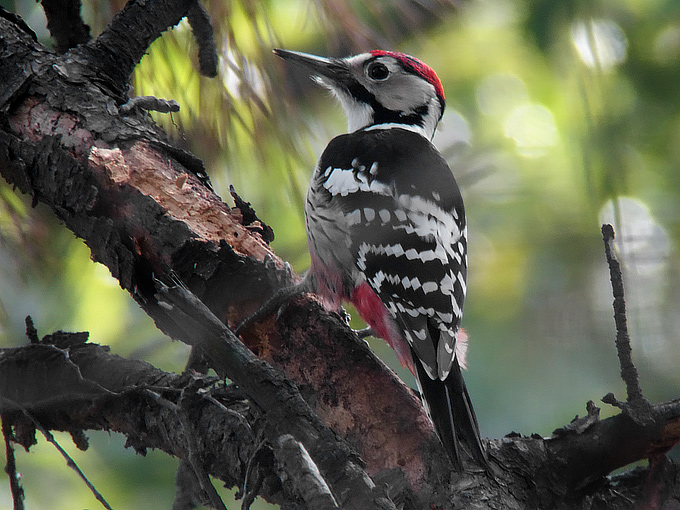
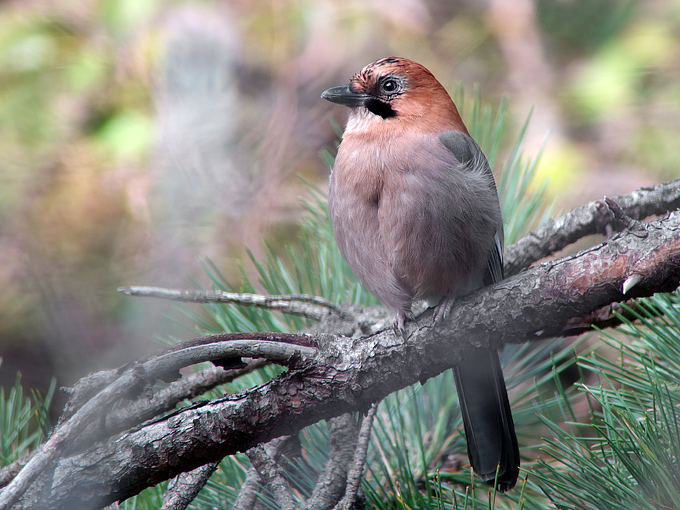
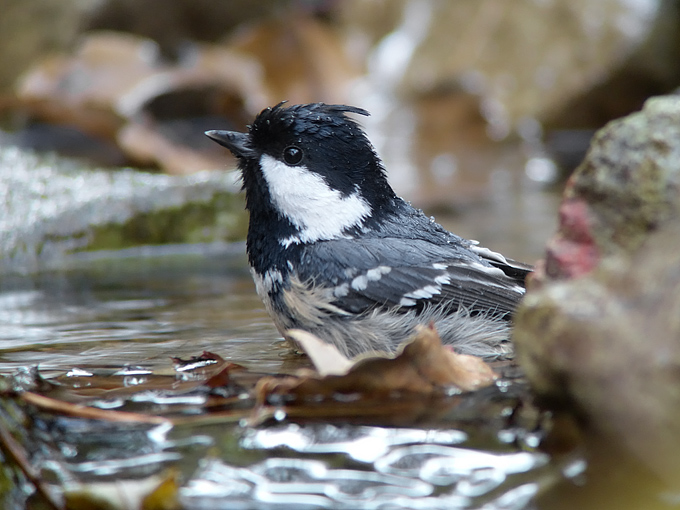
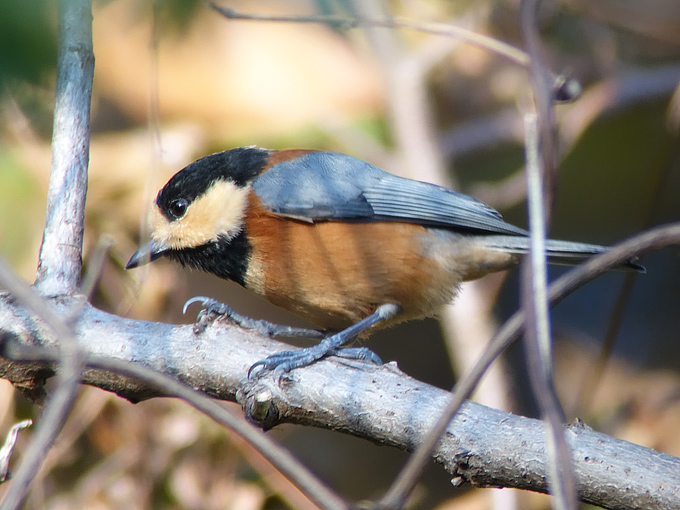
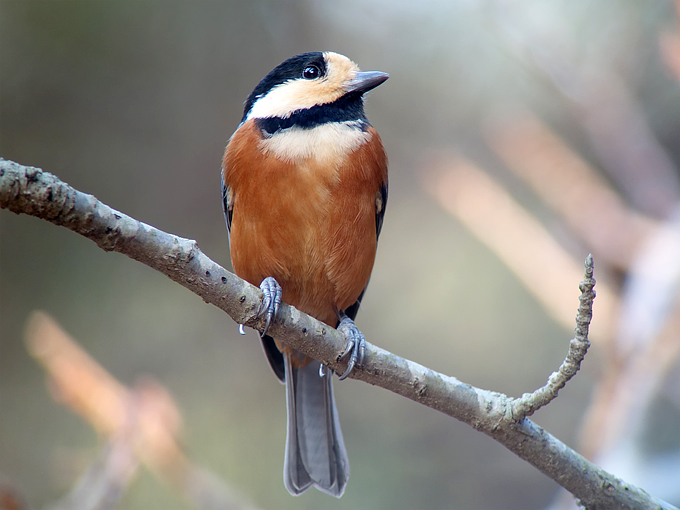

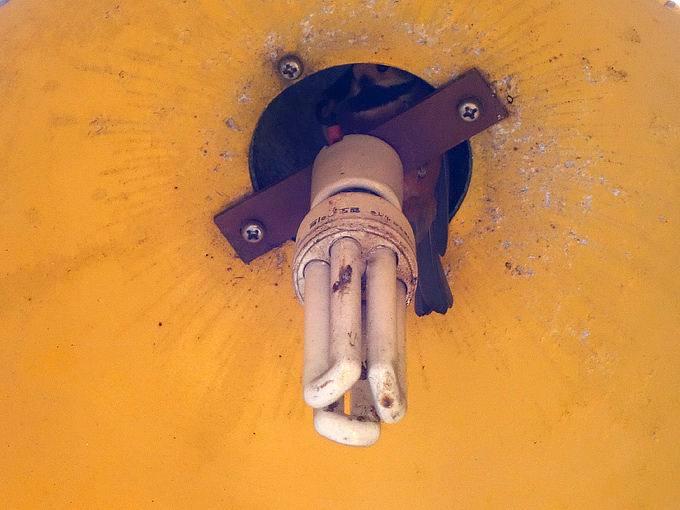
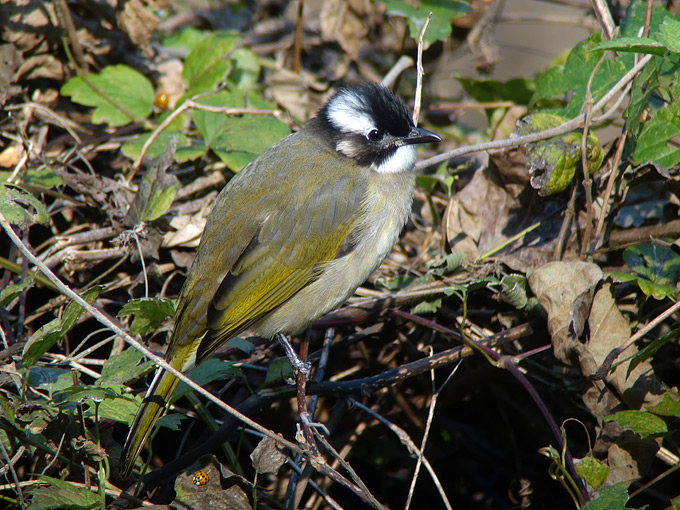
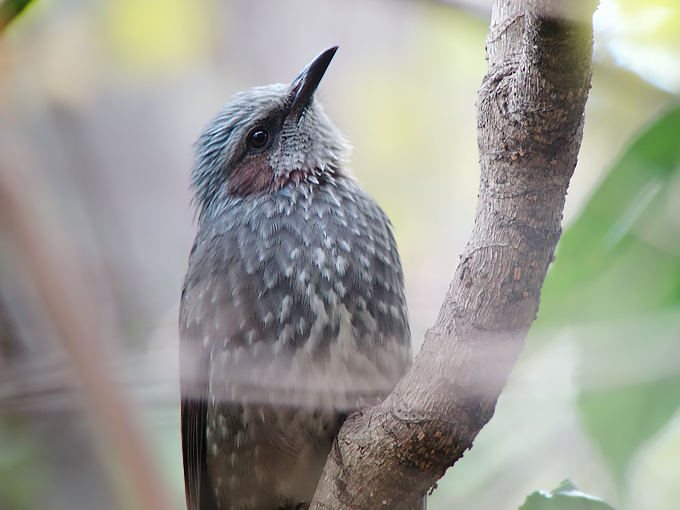
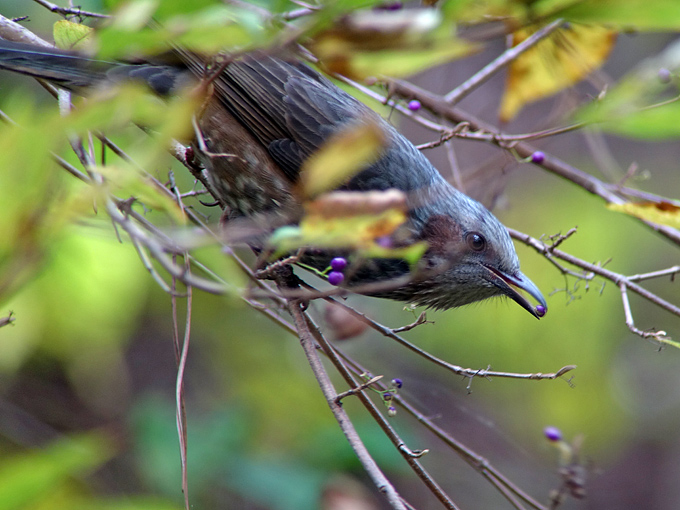
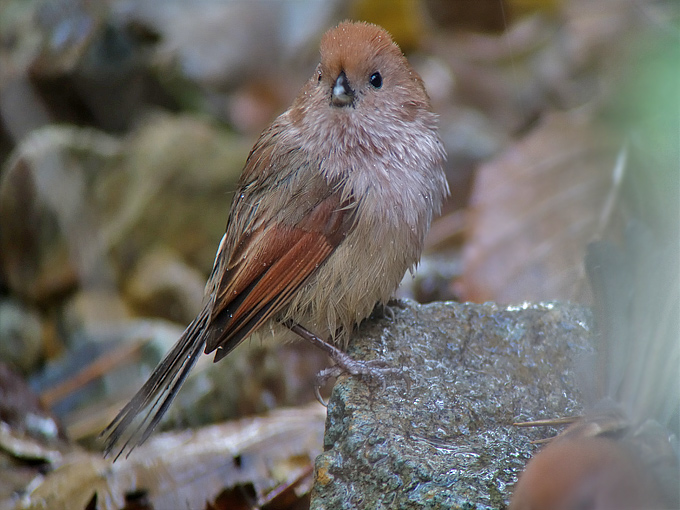
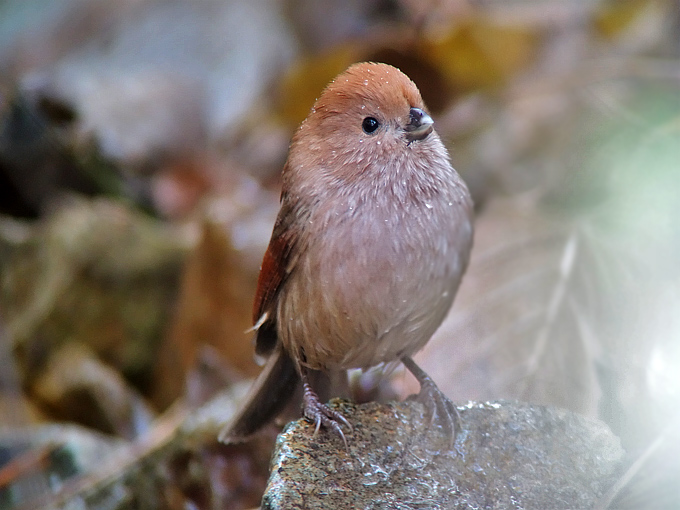
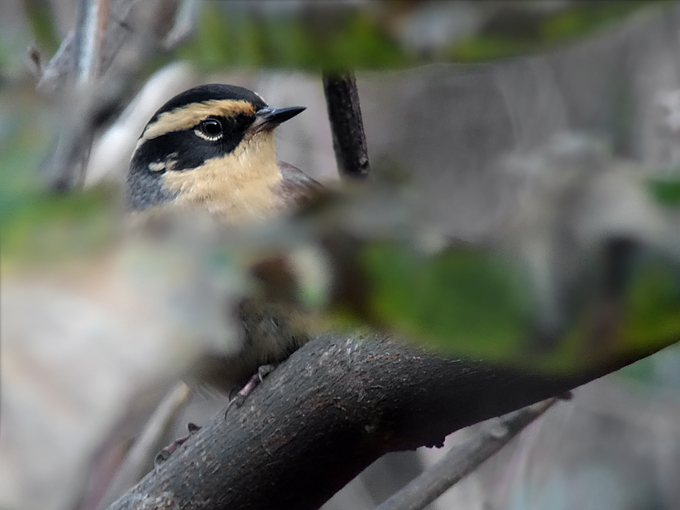
Mokpo Namhang Urban Wetland, November 15
The visit to the site in the morning in "grey" (cloudy and cold) weather showed quite a good number of birds. While the Common Greenshanks have now almost all left the site, the flock of Dunlin which was seen for over two weeks now is still on the site. Black-tailed Gulls are only in very small numbers for the last two week, but the number of Great Cormorant is slowly increasing.
Below today's list:
- Eurasian Wigeon Anas penelope, c. 30 in total.
- Mallard Anas platyrhynchos, less than 20 seen.
- Eastern Spot-billed Duck Anas zonorhyncha, 100 to 150, c. 30 in area P4; because of low tide in P1 larger groups roosting on floating platforms or swimming in the more "open" water between fishing boats.
- Northern Shoveler Anas clypeata, c. 40 in area. P4
- Eurasian Teal Anas crecca, most numerous with c. 200 individuals.
- Grey Heron Ardea cinerea, c. 20, most roosting on the now infilled area P2.
- Little Egret Egretta garzetta, only one on the tidalflat.
- Great Cormorant Phalacrocorax carbo, 19 seen on several platforms. Interesting to observe a scene with 2 individuals fighting over a piece of rope.
- Long-billed Plover Charadrius placidus, 2 in area P4 and 5 in area P1 seen.
- Common Greenshank Tringa nebularia, the number had dropped to 5.
- Common Sandpiper Actitis hypoleucos, only 3 seen.
- Red-necked Stint Calidris ruficollis, one was moving along with the Dunlins.
- Dunlin Calidris alpina, c. 50 actively feeding in two groups.
- Black-tailed Gull Larus crassirostris, only 4 seen all morning.
- Taimyr Gull Larus heuglini taimyrensis, one single individual, first seen in area P4, later again in area P1
- Oriental Turtle Dove Streptopelia orientalis, a group of five in the park area of the pump station.
- Eurasian Magpie Pica pica, all over the place, c. 30 in total.
- Eastern Great Tit Parus minor, two seen in a tree.
- Brown-eared Bulbul Hypsipetes amaurotis, two flying by.
- Eurasian Tree Sparrow Passer montanus, a flock of c. 20 moving between trees in the park area and bushes and trees in the area P2.
- White Wagtail Motacilla alba lugens, over 20 in total, some in area P1 and P4, but most in the park area.
- Grey-capped Greenfinch Chloris sinica, a flock of 17 in one tree.
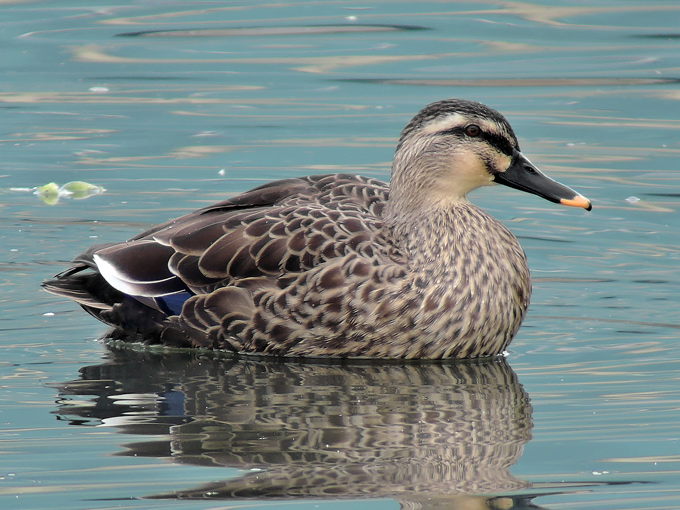
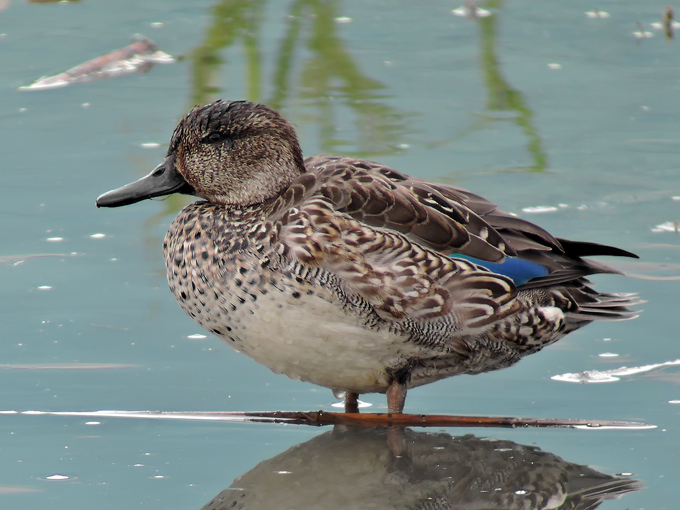
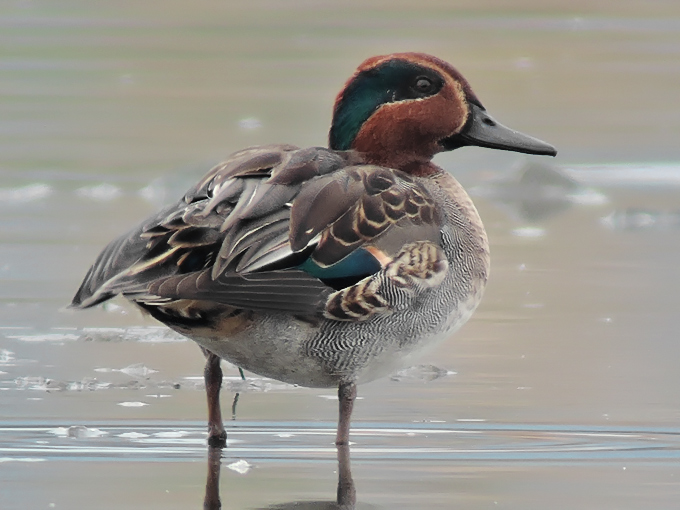
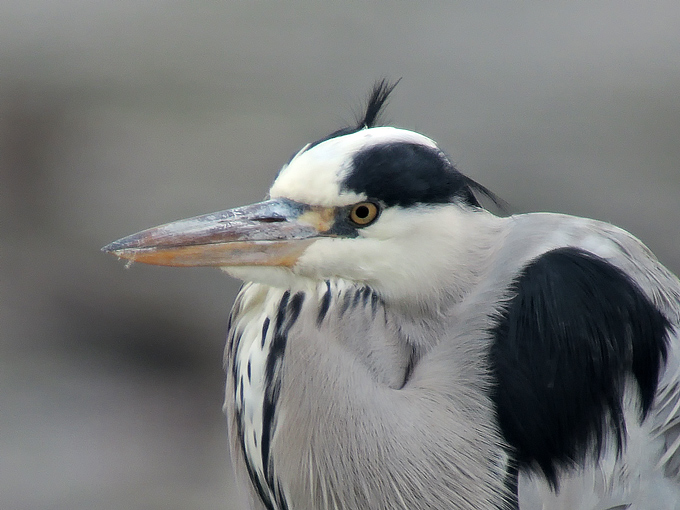
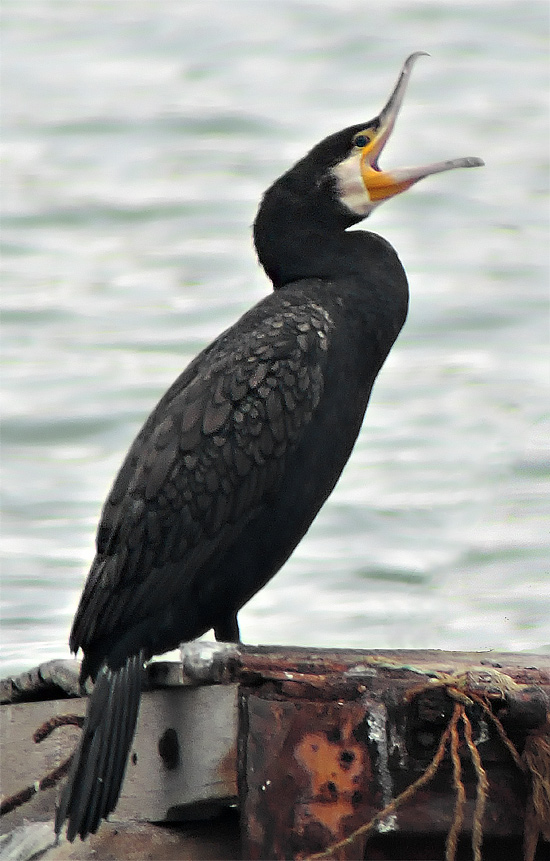


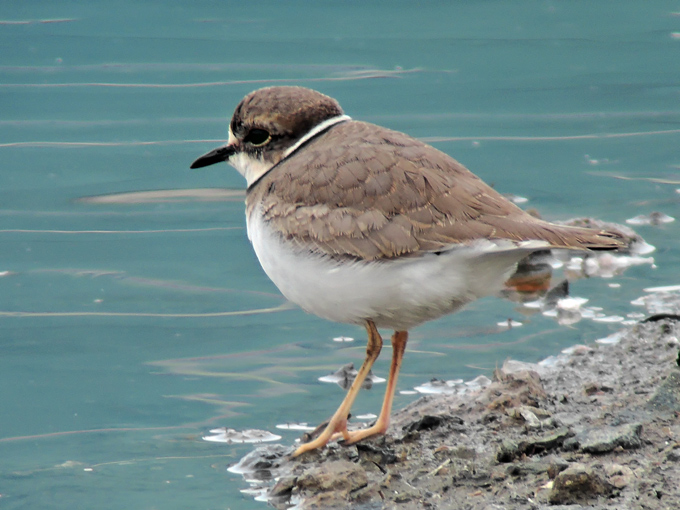
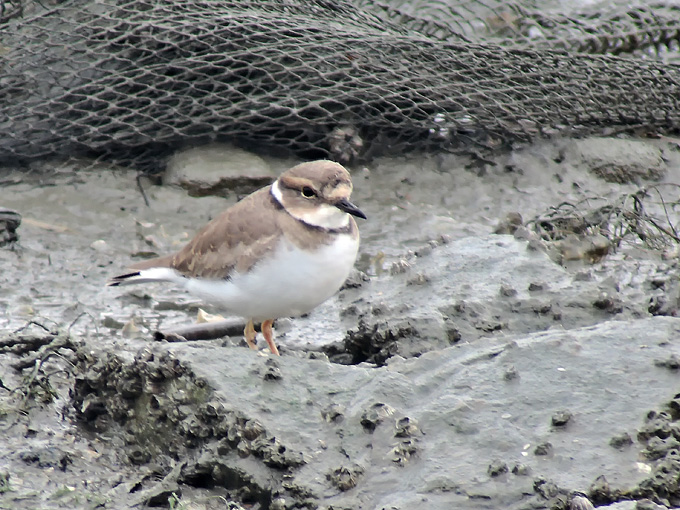
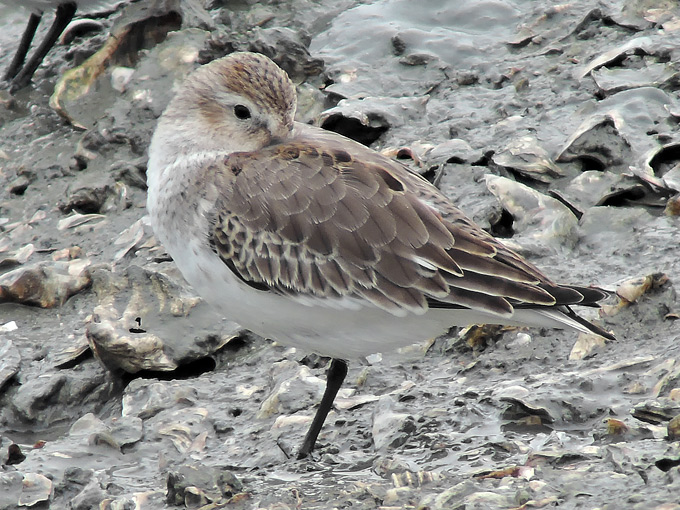
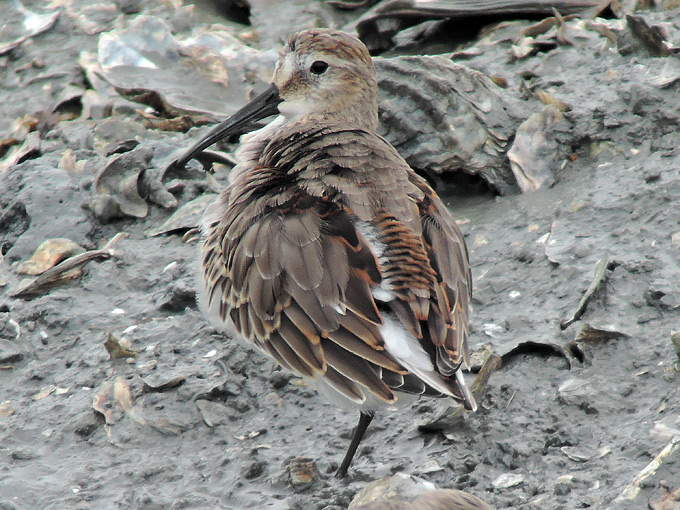
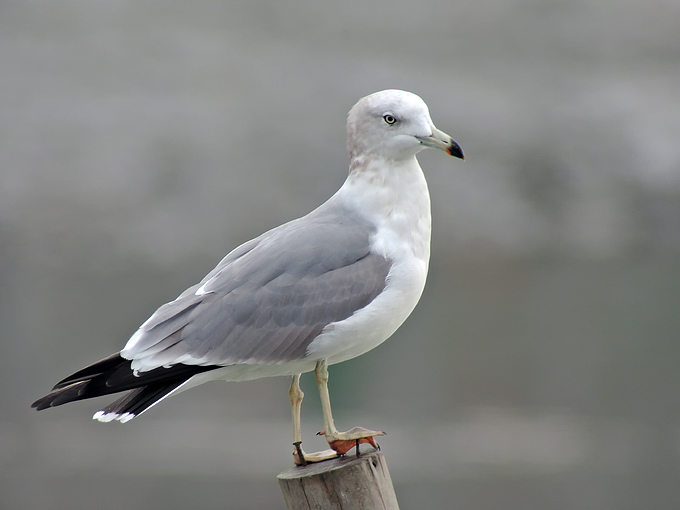

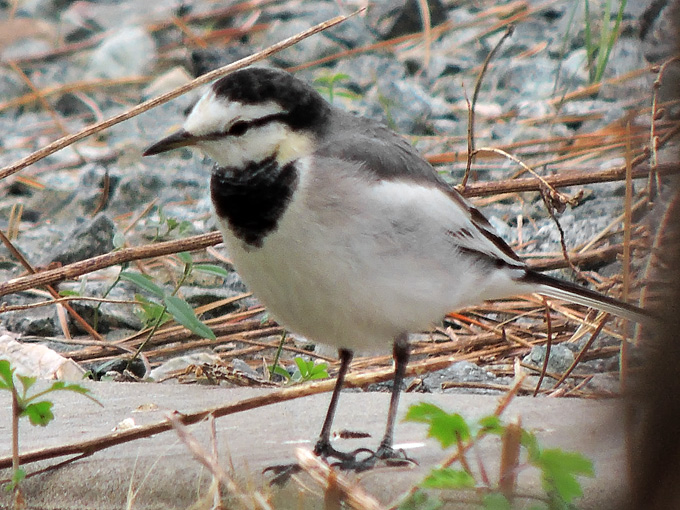
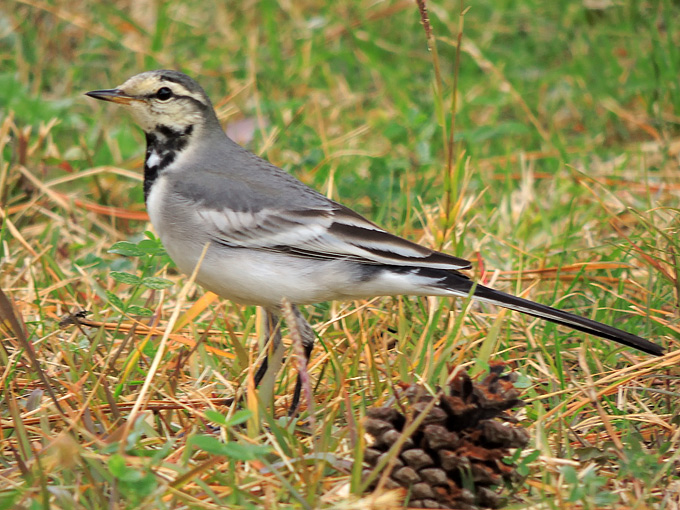
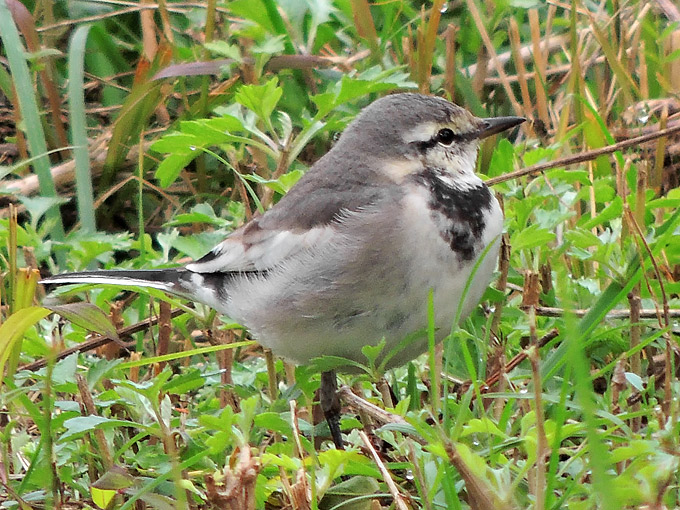
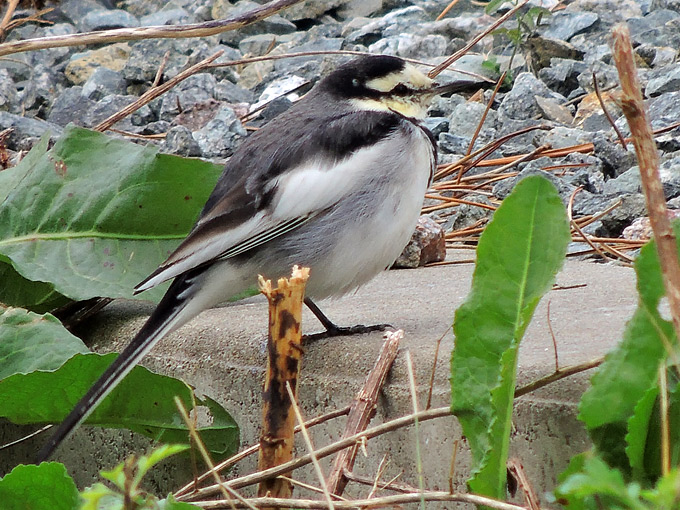
Ulleung Island, October 31 - November 5
I made a return visit to Ulleung Island to continue assessing migration strategies and to try to improve understanding of Ulleung’s “Big Three”: the Ulleung-endemic takahashii subspecies of White-backed Woodpecker; the globally Near Threatened Black Woodpigeon; and the distinctive Ulleung Varied Tit, described by Kuroda (1927) as an Ulleung-endemic subspecies utsurioensis.
On 31st, I took the morning ferry from Donghae to Ulleung (which proved to rather birdier than the ferry to Pohang) and surveyed Dodong in the afternoon. After overnight rain on the 1st, survey was attempted in the Nari basin, followed by some search effort in the far northeast, along the coast and up to Seokpo. On the 2nd, early morning rain and increasingly strong north-westerlies confined survey to parts of Dodong and Sadong in the less exposed east and southeast, where winds still gusted to F5-6. On the 3rd, winds fell from F5 north-westerlies to F3-4, and survey was attempted again at Nari, and then in Chodong. On the 4th, winds were light (NW F2), and visibility excellent, with temperatures ranging from an early morning 5C, with a light frost, to a high of 14C. Again, survey was conducted in the Nari basin; along the road from Nari to Cheonbu; and then in Hyeonpo. On the 5th, Taewa was surveyed (including for 1km or so upstream of the main road), and then the ferry was taken back to Pohang.
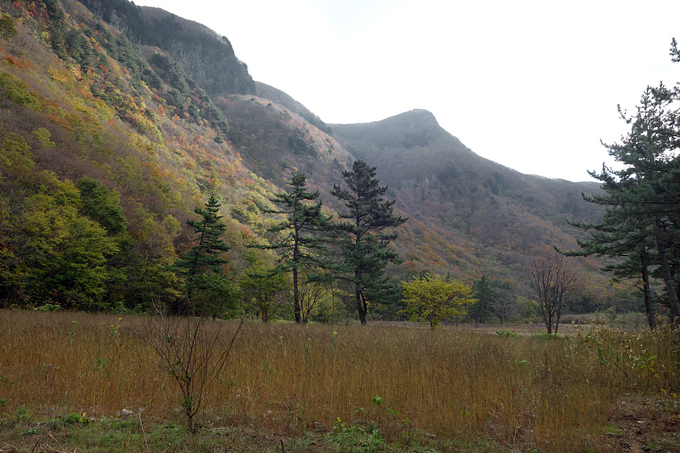
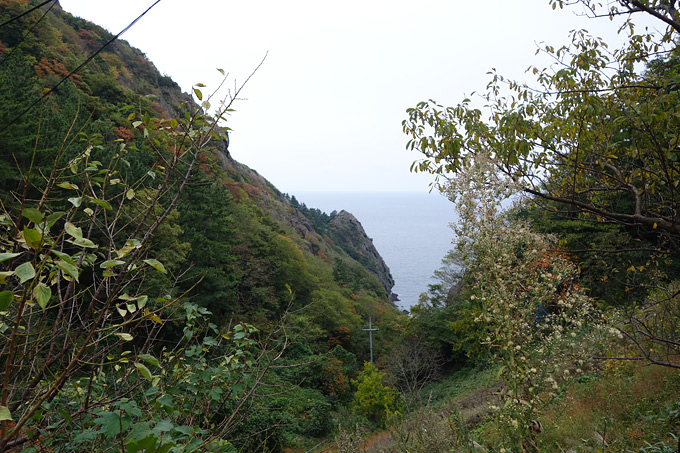
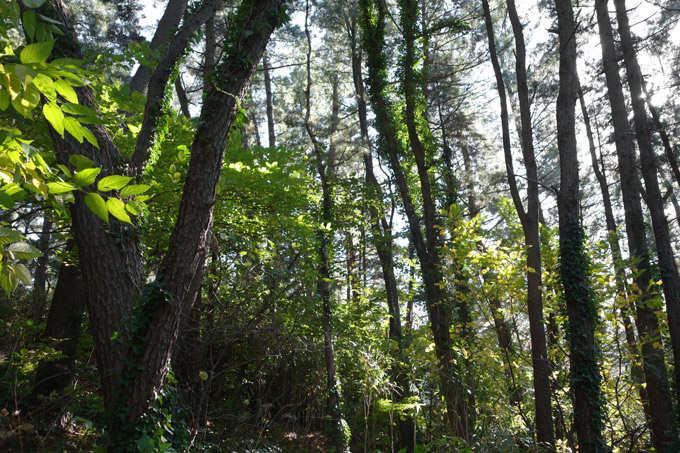
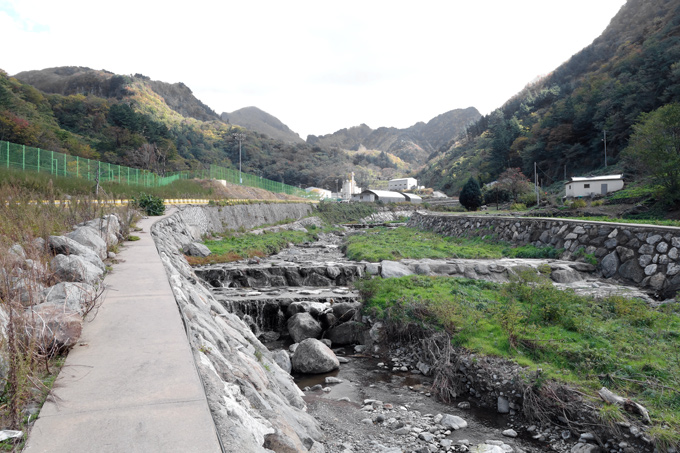
A total of 86 species were logged on Ulleung, with three additional species seen only from the ferry. In all, based on coarse calculations made through the excellent Daftlogic.com website, I surveyed between 5% and 10% of the island: on-foot, surveying along c.35km of roads and tracks and covering probably 370-400ha of forest, forest-edge and open ground well (so perhaps half of the more open areas on the island, but little of the higher-altitude forest in the island’s mountainous interior). I also made some observations from the bus each day (with >40km of coastal road travelled). Several areas were covered only once; others multiple times. All images were taken using a handheld Sony RX100 II through a truly superb Swarovski Optik telescope.
- Taiga Bean Goose Anser fabalis. One fairly small-billed individual in Hyeonpo on November 4th.
- Greater White-fronted Goose Anser albifrons. A total of four present (two in Chodong and singles in Hyeonpo, in the same field as two weeks earlier, and Taewa).
- Mandarin Duck Aix galericulata. Eight at Taewa on November 5th.
- Eurasian Wigeon Anas penelope. One in Nari on the 1st and one in Chodong.
- Mallard Anas platyrhynchos. Small numbers seen in several areas, with highest counts 11+ in Chodong and 12 in Taewa.
- Eastern Spot-billed Duck Anas zonorhyncha. Highest count was four in Taewa.
- Eurasian Teal Anas crecca. Small numbers seen in several areas, with at least 10 at Taewa the highest count.
- Common Pochard Aythya ferina. One flying around the Nari Basin in dense fog on the 1st.
- Tufted Duck Aythya fuligula. One at Taewa.
- Common Goldeneye Bucephala clangula. One on the sea on the 4th.
- Common Pheasant Phasianus colchicus. Widespread and very common, with at least 80 seen in Nari on the 1st (many giving a wide range of squeeks and squeeling calls).
- Streaked Shearwater Calonectris leucomelas. A total of 91 seen from the ferry on the 31st, including two just off from Ulleung, and 22 seen from the ferry on the 5th (all within c. 50km of Pohang)
- Swinhoe’s Storm Petrel Oceanodroma monorhis. One seen from the ferry on the 31st, about 15km from Donghae.
- Little Grebe Tachybaptus ruficollis. One at Cheonbu and four in Chodong on the 4th.
- Great Crested Grebe Podiceps cristatus. In addition to one at sea on 31st about 50-60km from Donghae, singles in Cheonbu, Hyeonpo and Chodong.
- Black-necked Grebe Podiceps nigricollis. One at Cheonbu on the 1st.
- Grey Heron Ardea cinerea. Small numbers (1-5) seen daily.
- Western Great Egret Ardea alba alba. Three near Cheonbu on several dates.
- Pelagic Cormorant Phalacrocorax pelagicus. One on the 5th.
- Great Cormorant Phalacrocorax carbo. Two in Cheonbu harbor on the 1st: hanedae or sinensis?
- Temminck’s Cormorant Phalacrocorax capillatus. Found along the coast and in several harbours in small numbers.
- Japanese Sparrowhawk Accipiter gularis. Singles seen on several dates.
- Eurasian Sparrowhawk Accipiter nisus. Again, the most numerous raptor with 23 “encounters” during the survey period.
- Northern Goshawk Accipiter gentilis. One on the 31st.
- Eastern Buzzard Buteo japonicus. Singles seen on three dates.
- Eurasian Coot Fulica atra. Four in Chodong harbor and one at Taewa.
- Common Snipe Gallinago gallinago. One or two in the Nari basin on the 1st.
- Dunlin Calidris alpina. In addition to 12 shorebirds seen about 50km off Donghae which were thought to be this species, one in the stream at Taewa was considered probably the same as the one seen there in late October.
- Black-legged Kittiwake Rissa tridactyla. Five (four adults and one First-winter) were seen moving north off Chodong on the 3rd.
- Black-headed Gull Chroicocephalus ridibundus. Only seen from the ferry, with 50+ about 5-10km offshore from Donghae on the 31st.
- Black-tailed Gull Larus crassirostris. The commonest gull, with 700+ on the 4th the highest day count.
- Common Gull Larus canus. One from the ferry on the 31st and one in Chodong on the 3rd.
- Glaucous-winged Gull Larus glaucescens. A First-winter was off Sadong on the 2nd.
- Vega Gull Larus vegae. The commonest large gull, with 600-800 seen in total around the island.
- Mongolian Gull Larus mongolicus. One in Chodong on the 3rd.
- Slaty-backed Gull Larus schistisagus. Seen daily in small numbers, with 50+ on the 2nd the highest day count. As always at this time of year, individual variation was extraordinary with both fresh-looking dark juveniles and worn- and bleached-looking First-winters.
- Taimyr Gull Larus heuglini taimyrensis. Seen daily in small numbers, with 5+ the highest day count.
- Black Wood Pigeon Columba janthina. At least 42 found by this survey (58-61 if the October 20th-25th survey is included, and if none of the birds were double-counted). This number is rather higher than the numbers found, according to Heritage TV, by "precise survey of Ulleungdo: 35 in 2003; 20 in 2009, and 32 in 2011. Numbers are reducing" (thanks to Tim Edelsten for this information). Considering that: (1) two of the survey dates were affected by strong winds; (2) many are thought to emigrate off the island in winter; and (3) that many suitable-looking areas were not visited, it still seems likely that the island population of this species will be >200, and could even be as many as 400-500 individuals. It is apparent that a proper focused survey would be helpful to establish more fully the global importance of Ulleung to this secretive species.
- Oriental Turtle Dove Streptopelia orientalis. Small numbers (3-10) seen each day.
- White-backed Woodpecker Dendrocopos leucotos. Only three heard and two others seen despite much searching. A more detailed account is provided at: The “Ulleung Woodpecker” Dendrocopos leucotos takahashii
- Common Kestrel Falco tinnunculus. Between one and three seen daily.
- Peregrine Falcon Falco peregrinus. Between one and four seen daily, including one in pursuit of a Black Wood Pigeon, and with perhaps four occupied territories on the island.
- Bull-headed Shrike Lanius bucephalus. Between one and three on several dates.
- Rook Corvus frugilegus. One in Sadong on the 2nd.
- Coal Tit Periparus ater. Some evidence of immigration during the survey period, with small numbers found in coastal bushes in the northeast, and an apparent increase in numbers island-wide during this short survey period. The highest day count was 25+ on the 4th.
- Varied Tit Sittiparus varius. Although less common than Eastern Great Tit in woodland in the northeast, pairs or small groups were commoner in other parts of the island, and were found in all wooded and park-type areas, with a high day count of 40+ and a total of >150 encountered. As noted in autumn 2013, all individuals showed some suffusion of orange-brown into the blue-grey of the back and mantle. All also showed orangey-suffusion in the paler parts of the head, breast and through the centre of the belly. Birds therefore appeared darker and obviously less clean blue and orange than birds seen on the mainland the same week. In addition, the impression that Ulleung Varied Tits often look quite strong-billed appears to be supported by the historical research of Kuroda (1927), who described this population as an endemic subspecies with a longer bill (15mm along the entire culmen) than populations on the mainland and in Jeju (both 13.5mm along the entire culmen). Is this longer bill a result of lack of competition from Eurasian Nuthatch or Japanese Pygmy Woodpecker?
- Eastern Great Tit Parus minor dageletensis. Common and widespread, with 30+ the highest day count.
- Chinese Penduline Tit Remiz consobrinus. One heard on the 1st and one seen at Cheonpo on the 3rd.
- Eurasian Skylark Alauda arvensis. Small numbers (5-20) were at Nari and heard passing over the island on several dates.
- Far Eastern Skylark Alauda japonica intermedia. At least 35 of the 40 skylarks seen and heard in good conditions on the 4th were identified as this taxon. In direct comparison with Eurasian Skylark, they gave harsher calls, appeared smaller, shorter-tailed, shorter-crested, darker and more obviously rust-toned, with cleaner breast bands.
- Brown-eared Bulbul Hypsipetes amaurotis. Common and widespread, with 50 on the 3rd the highest day count.
- Japanese Bush Warbler Horornis diphone. Two singles were heard.
- Long-tailed Tit Aegithalos caudatus. Becoming more widespread and obvious during the survey period, with probably 30 on the 4th the highest day count. The most numerous type was “southern” (presumably magnus), with 6-8 “northern” (presumably caudatus) seen on the 4th, when there was also one apparent intergrade.
- Japanese White-eye Zosterops japonicus. Rather local, with 3-6 logged each day.
- Goldcrest Regulus regulus. Small numbers logged each day, with some evidence of immigration during the survey period and highest day counts of 8 on the 3rd and 10 on the 4th.
- Eurasian Wren Troglodytes troglodytes. Most regular along small streams and on steep forested slopes, with small numbers (5-10) logged each day
- White-cheeked Starling Spodiopsar cineraceus. Twenty-five were in Hyeonpo on the 4th.
- Common Starling Sturnus vulgaris. At least one was with the White-cheeked Starling flock in Hyeonpo on the 4th.
- Eye-browed Thrush Turdus obscurus. One was heard on the 4th near Cheonbu.
- Dusky Thrush Turdus eunomus. Between three and five on most dates.
- Red-flanked Bluetail Tarsiger cyanurus. Remarkably scarce, with the high count two (on 31st).
- Daurian Redstart Phoenicurus auroreus. Logged each day, with 55 encounters and a highest day count of 15 on the 3rd.
- Blue Rock Thrush Monticola solitarius. Small numbers present along the coast only, with 1-5 seen most dates.
- Stejneger’s Stonechat Saxicola stejnegeri. Two in Nari on all dates and three in Hyeonpo (on the 4th).
- Russet Sparrow Passer rutilans. Ones or twos were found in Dodong (on 31st), Sadong (3rd), Nari (4th) and Taewa (5th).
- Siberian Accentor Prunella montanella. The only record was of c.3 heard in sustained overhead flight over the Nari Basin on the 4th.
- Grey Wagtail Motacilla cinerea. Between one and four seen on most dates.
- White Wagtail Motacilla alba. Between two and five seen on most dates (all lugens).
- Olive-backed Pipit Anthus hodgsoni. Remarkably scarce, with the highest day count 10+ on the 4th.
- Red-throated Pipit Anthus cervinus. One on the 1st was the only record.
- Buff-bellied Pipit Anthus rubescens. The commonest pipit, with the largest flock 120 (in Nari on the 1st), with additional smaller flocks in e.g. Sadong (30+) and Taewa (10+).
- Brambling Coelebs montifringilla. On 31st, in heavy overcast, a single flock of 380 flew over Dodong, with several smaller groups seen heading southwest. On the 1st, 900-1000 were present, with largest numbers in Nari. Subsequently, numbers fell rapidly, with only 25-30 logged on the four subsequent dates.
- Hawfinch Coccothraustes coccothraustes. One on the 1st was the only record.
- Japanese Grosbeak Eophona personata. One on the 31st, moving south with a flock of Brambling, was the only record.
- Common Rosefinch Carpodacus erythrinus. One heard in or over Nari on the 4th was the only record.
- Long-tailed Rosefinch Carpodacus sibiricus. Although several were seen in Gangwon Province on the 30th, not logged until the 4th, when three were in Nari and one was heard at Hyeonpo.
- Pallas’s Rosefinch Carpodacus roseus. Two in Nari on the 1st; two near Cheonbu on the 3rd; and at least five in the Nari area on the 4th.
- Grey-capped Greenfinch Chloris sinica. Between one and three logged each day. Although some vocalisations sound subtly different to some mainland birds (island acoustics? Origin?) , it is unclear why Kuroda (1927) considered this a distinct, Ulleung-endemic subspecies.
- Common Redpoll Acanthis flammea. Seven or eight were in Nari and Seokpo on the 1st; and two were in Nari on the 3rd.
- Eurasian Siskin Spinus spinus. On 31st, 150 were in Dodong and on 1st, 1,200 were logged in Nari and Seokpo – with flocks watched moving west across the island. Only 15-50 were logged on subsequent dates.
- Pine Bunting Emberiza leucocephalos. One in Nari on the 4th was the only record.
- Little Bunting Emberiza pusilla. One seen in Nari on the 4th was the only record.
- Rustic Bunting Emberiza rustica. Seen daily in small numbers, with 5-25 most dates and 40 on the 4th the highest day count.
- Yellow-throated Bunting Emberiza elegans. Seen daily in small numbers, with 3-10 most dates and 25 on the 4th the highest day count.
- Black-faced Bunting Emberiza spodocephala. Remarkably scarce, with one heard on the 1st the only record.
- Pallas’s Reed Bunting Emberiza pallasi. One in Nari increasing to six there on the 4th.
- Ochre-rumped Bunting Emberiza yessoensis. One in Nari on the 4th.
- Common Reed Bunting Emberiza schoeniclus . One on 3rd and two on the 4th.
- Lapland Longspur Calcarius lapponicus. Three were in Nari on the 4th.
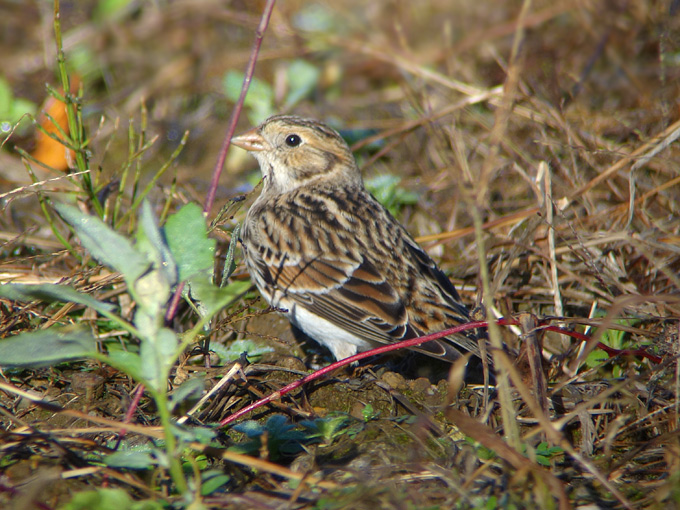 Lapland Longspur Calcarius lapponicus, © Nial Moores
Lapland Longspur Calcarius lapponicus, © Nial Moores
